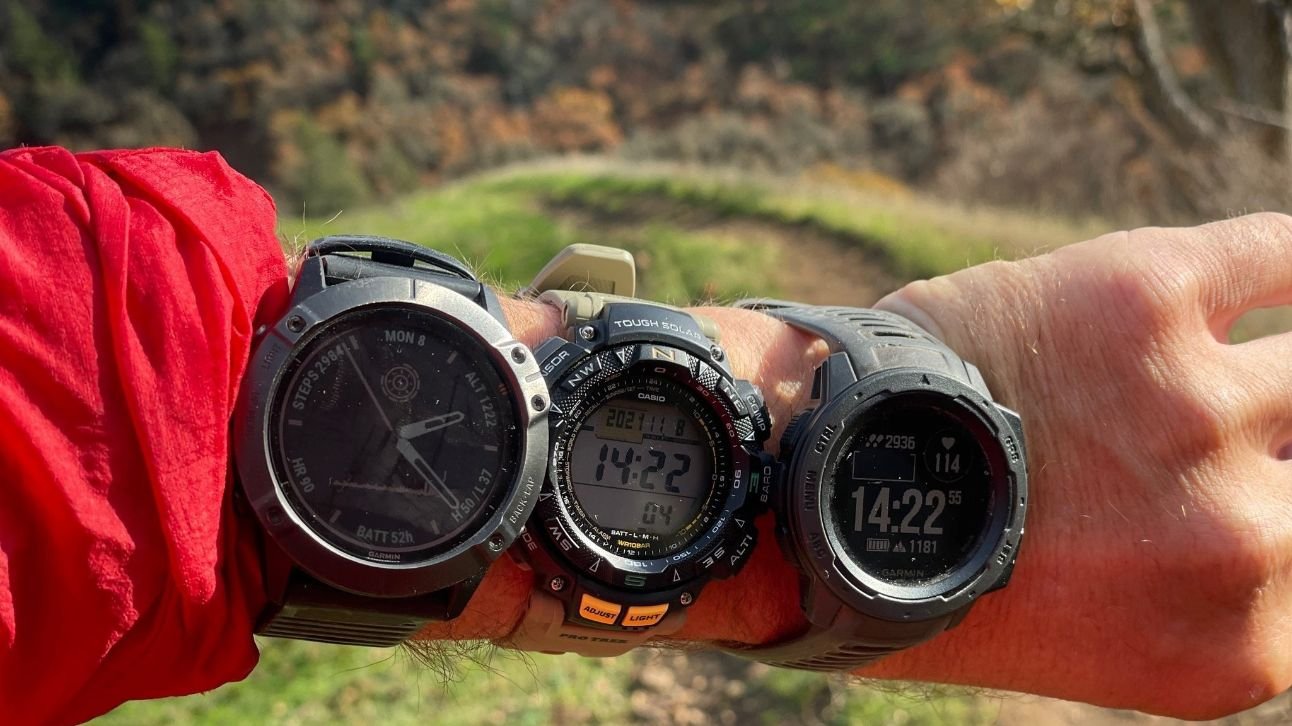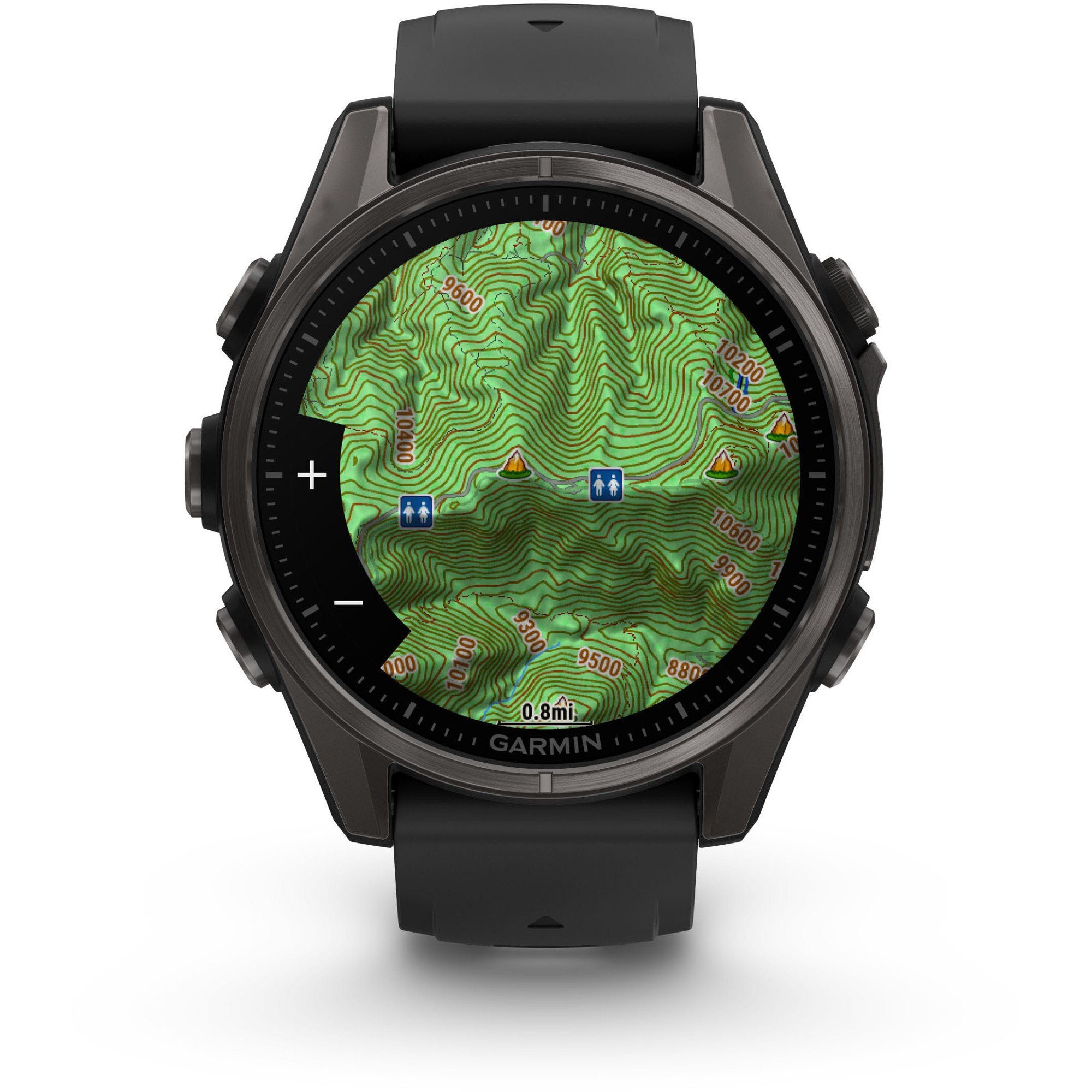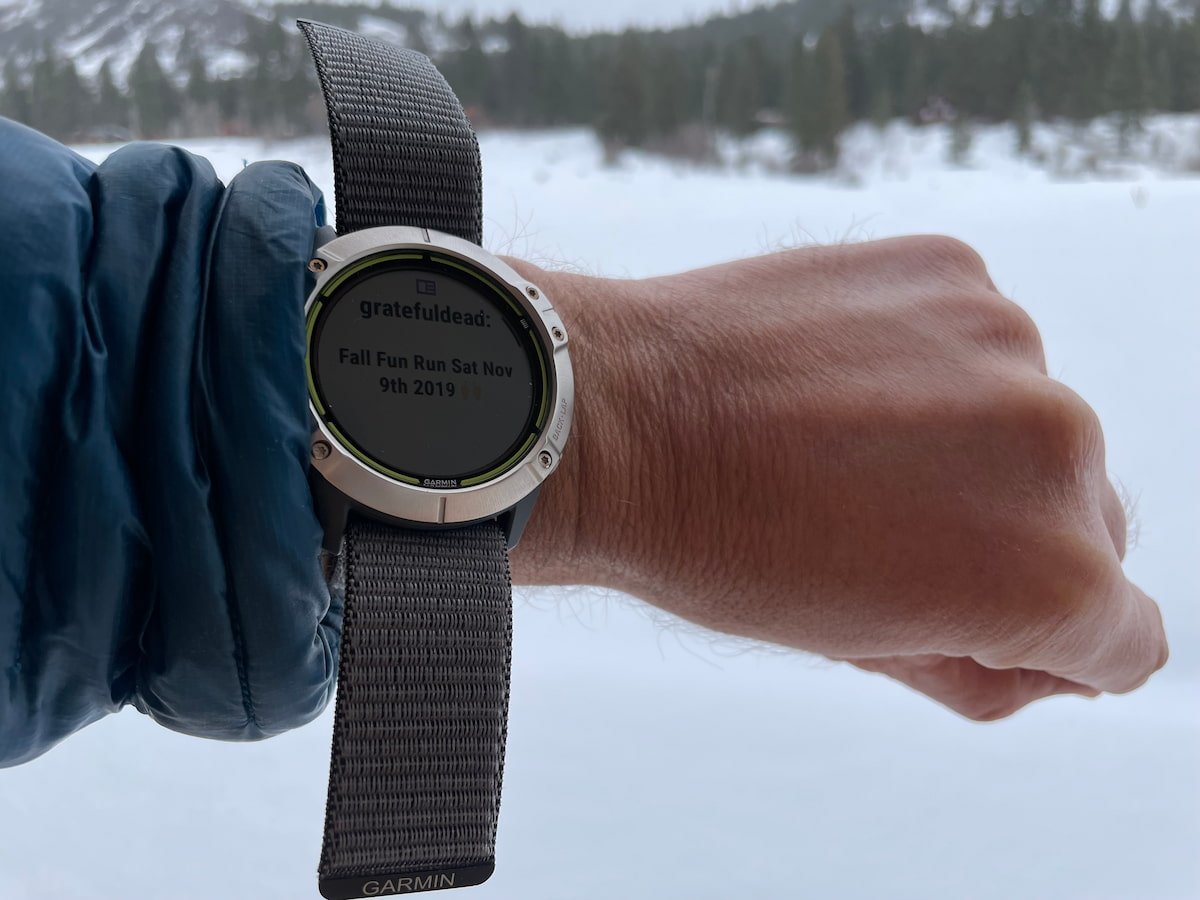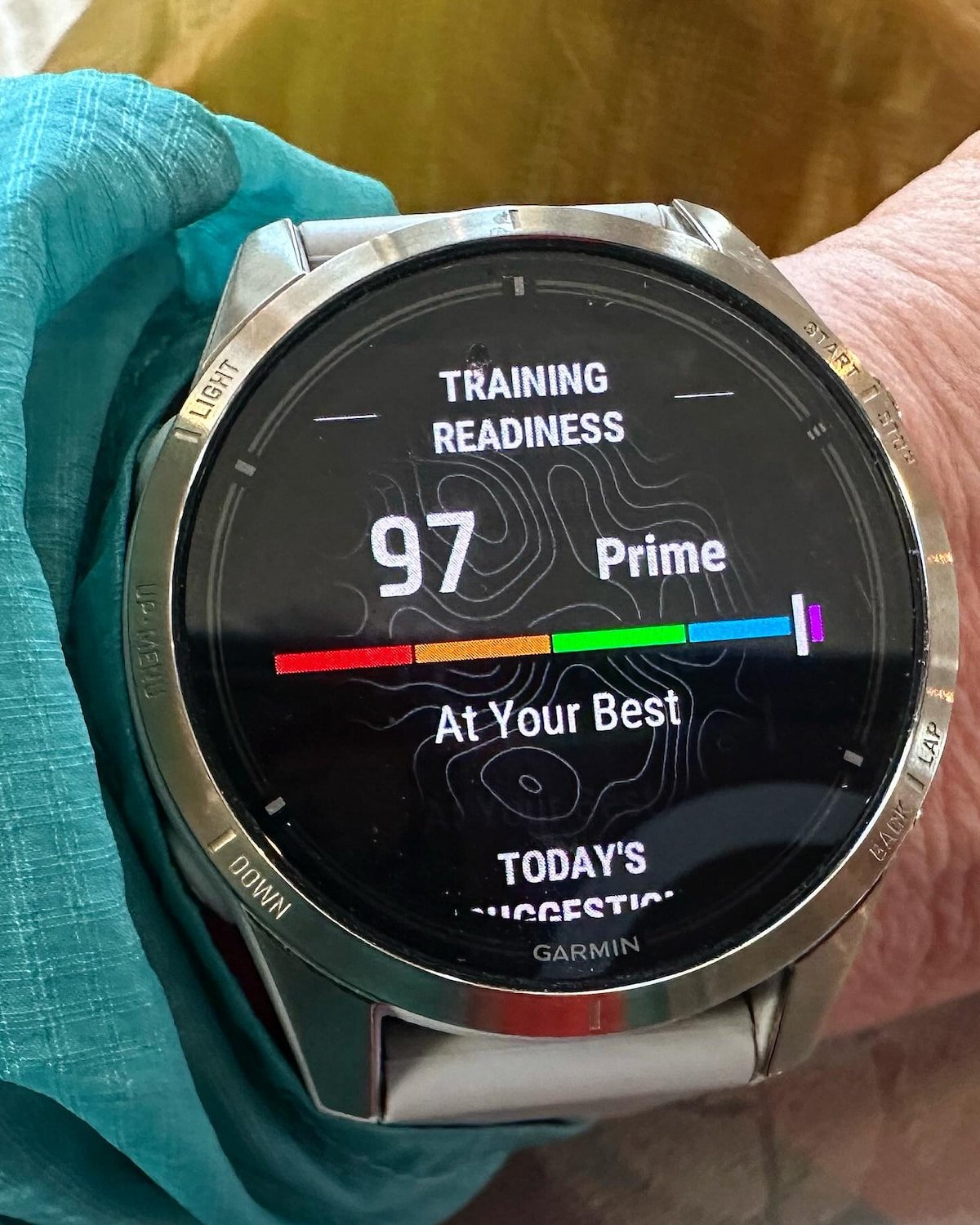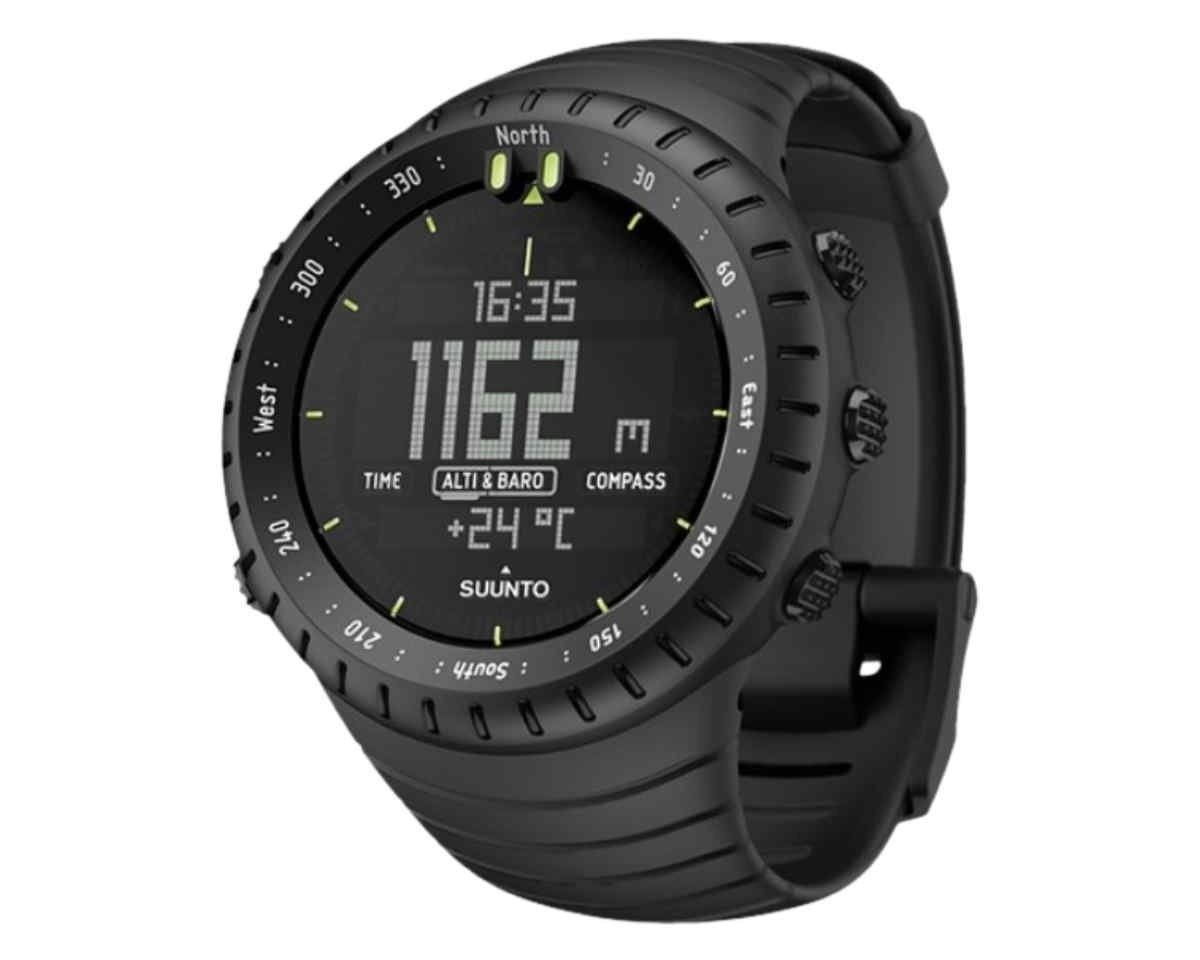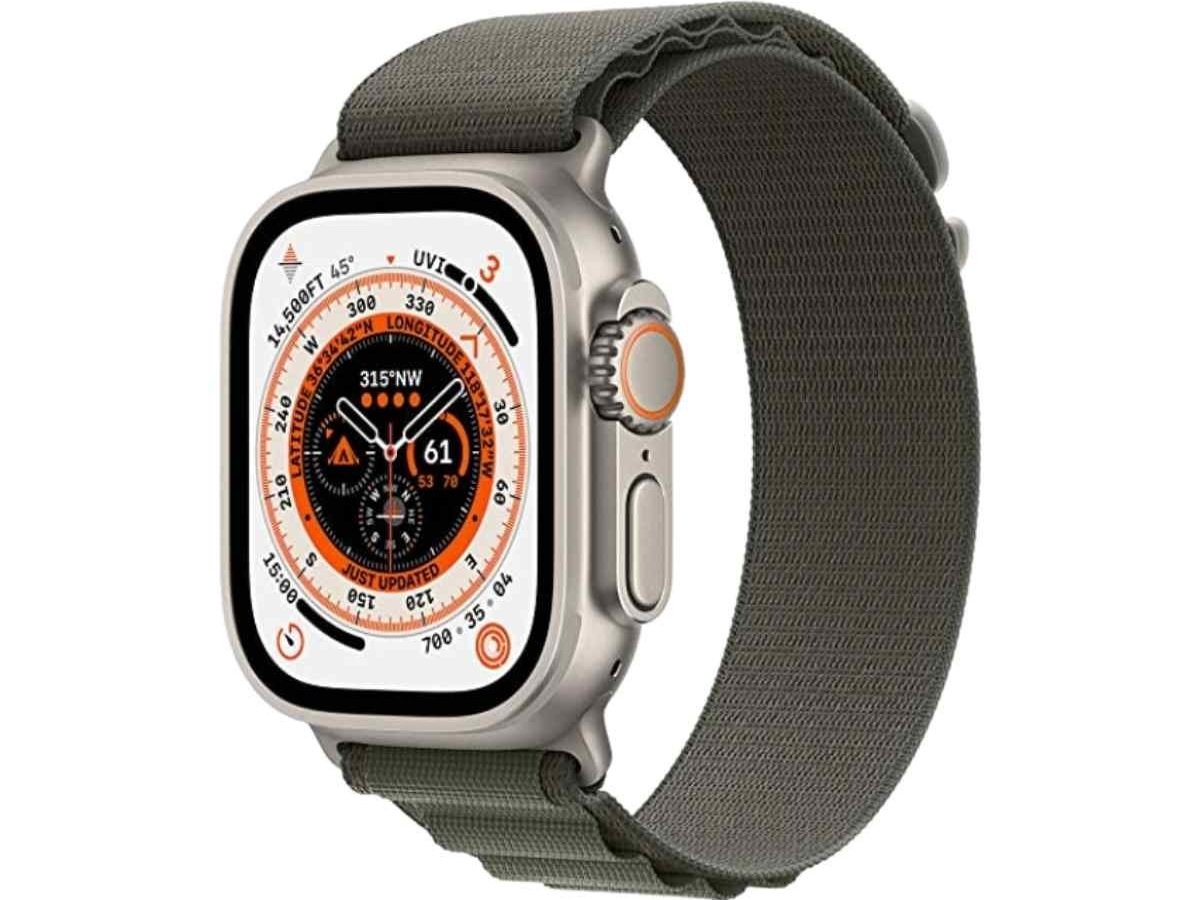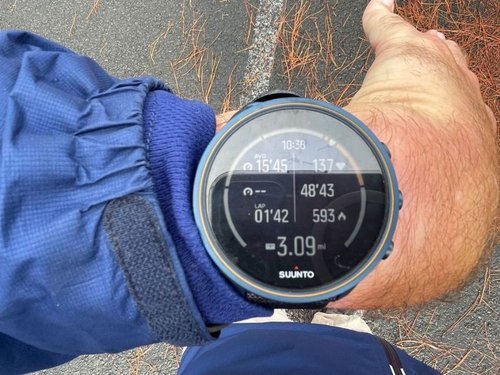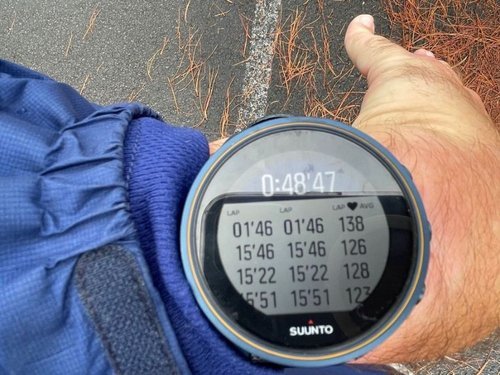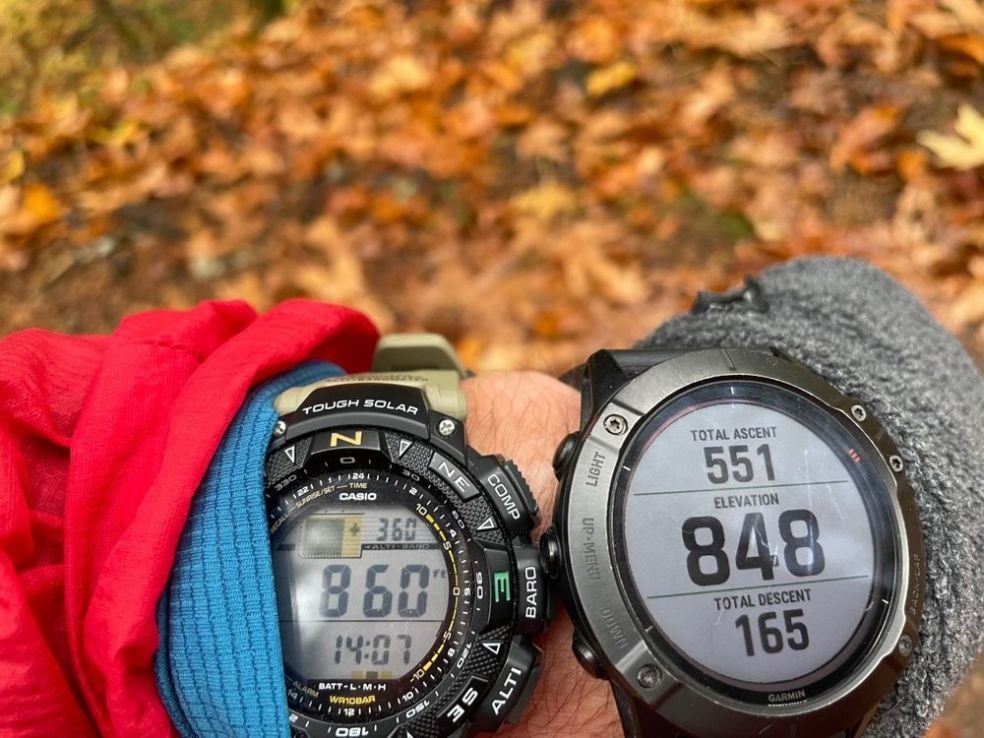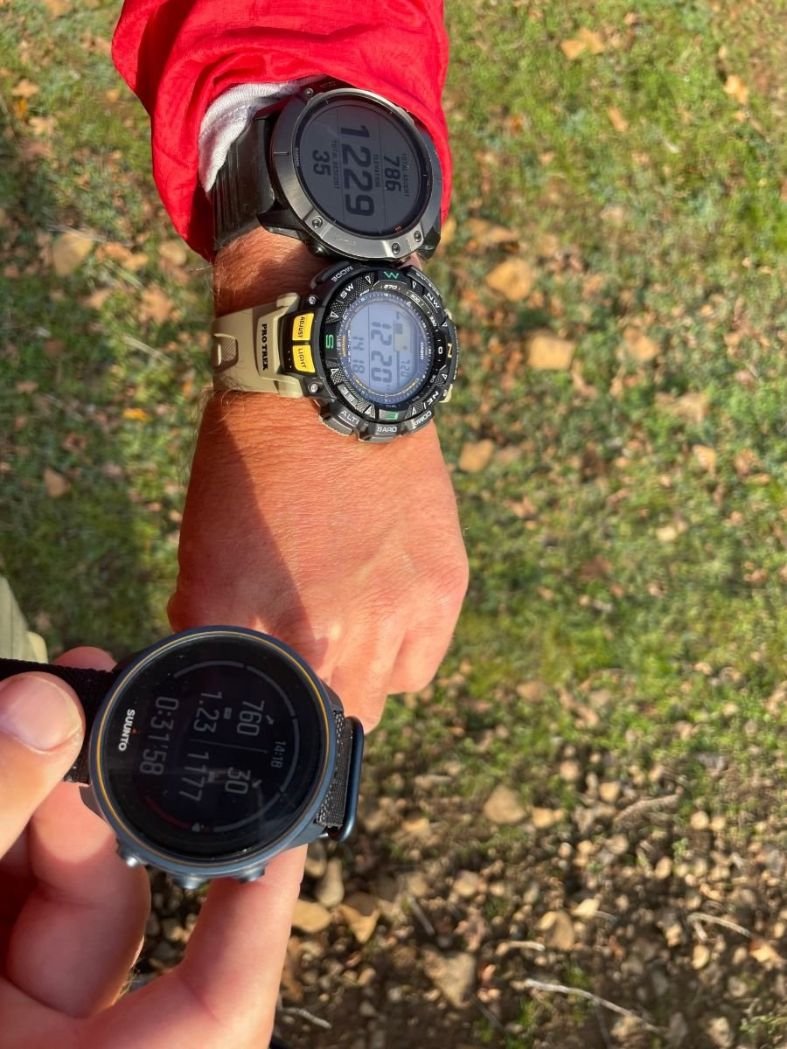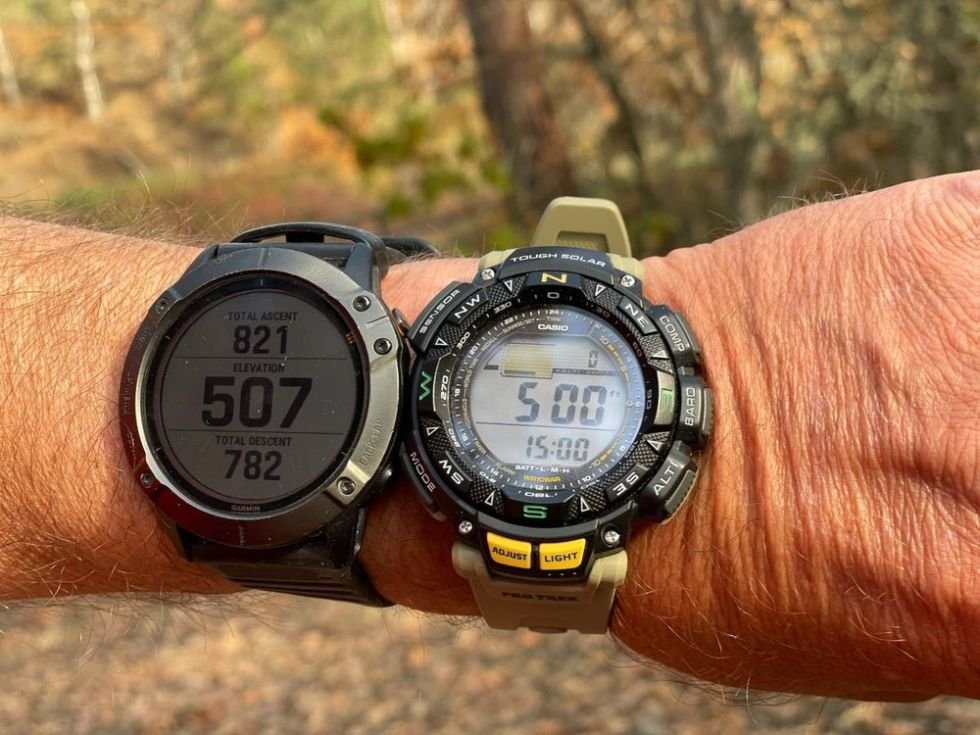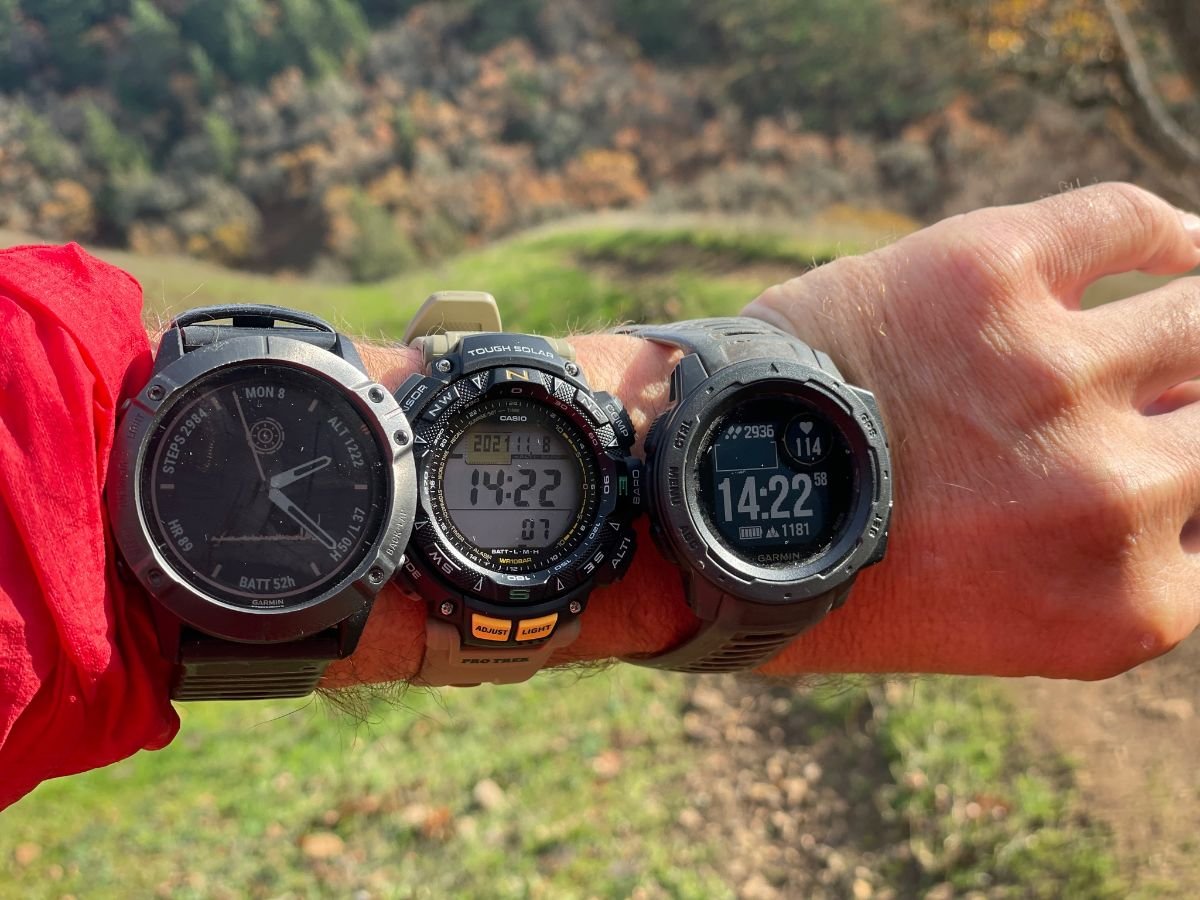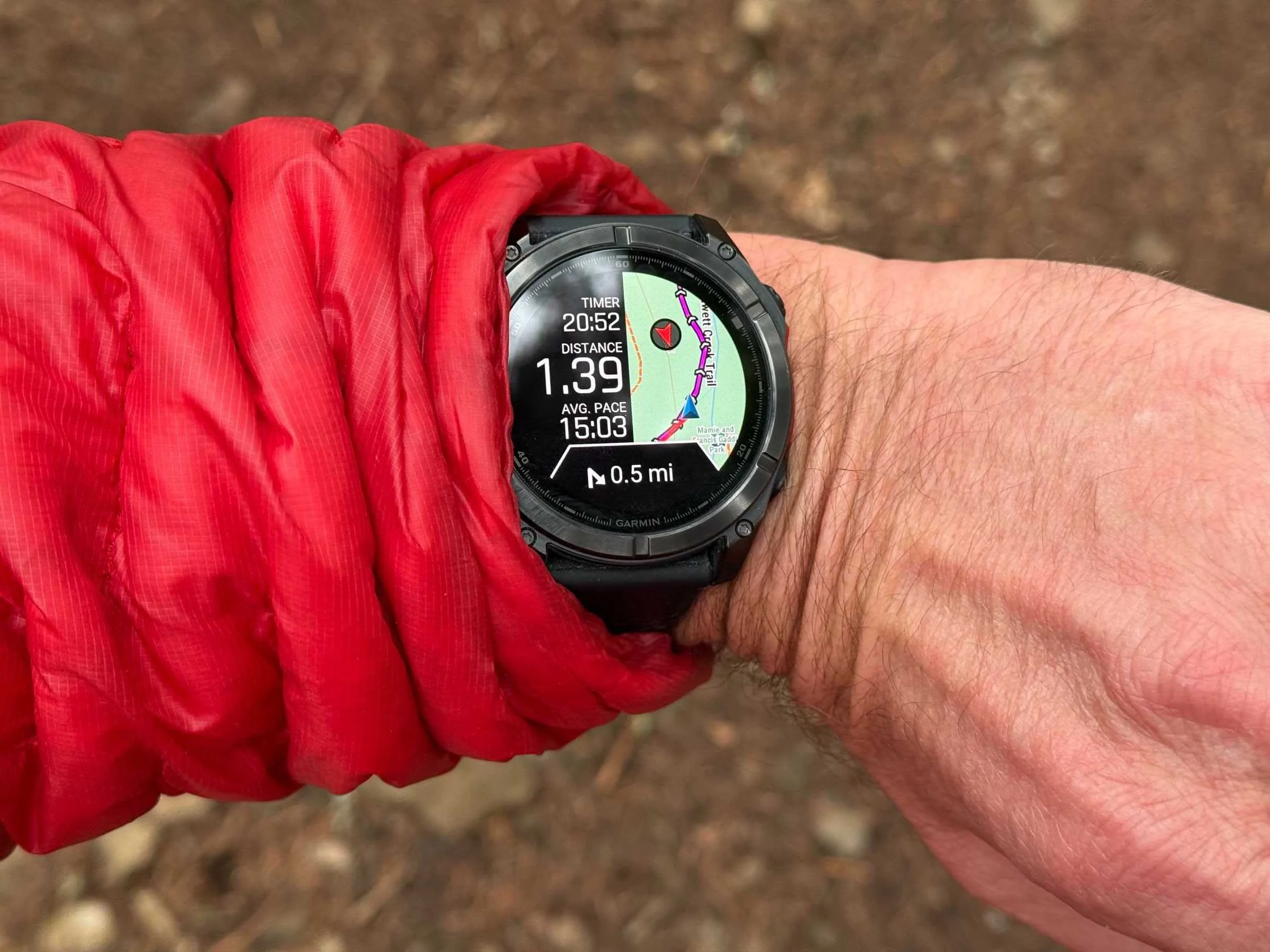Best Hiking and Backpacking Watches of 2025
GPS and ABS watches with the best tracking, features, Display, and battery life
Home > Gear Reviews > Electronics
April 9, 2025, updated with the Apple Watch Series 10
An ABC hiking watch—a watch with altitude, barometer, and compass functions (the ABCs)—is an essential piece of backcountry gear. Choosing the best GPS watch or ABC watch depends on how you plan to use it. We put in 100s of hours of research and over 300 hiking days to determine the best hiking and backpacking watches.
The Garmin Instinct 2 Solar is the best GPS hiking and backpacking watch for most people. If you want more features and exceptional battery life, the fenix 7X Sapphire Solar is our upgrade pick. We also love the Garmin Enduro 2 if you want all the fenix 7X Sapphire Solar features with even more battery life. For folks who just want ABC functionality without GPS or lifestyle functions like activity tracking, the Suunto Core is still a great option.
We also examine how our top winners stack up against the new Apple Watch Ultra 2, Coros Vertix 2, Suunto 9 Peak Pro, Casio Pro Trek PRW3500-1, and Garmin epix Pro (Gen 2).
I have used Treeline’s top hiking watches on many long-distance thru-hikes. I used the Suunto Core as an essential part of my hiking kit on the Pacific Crest Trail, Continental Divide Trail, Appalachian Trail, and other thru-hikes. I switched to the Garmin Instinct in early 2019 and used it on thru-hikes of the Arizona Trail, Pacific Crest Trail (southbound), and Ouachita Trail. In 2020, I updated to the Garmin fenix 6X Solar to use the full GPS capabilities for thru-hikes of the Blue Mountain Trail, Oregon Desert Trail, and Mogollon Rim. I then further upgraded in late 2022 to the fenix 7X Sapphire Solar for the Northern New Mexico Loop and more recently have tested the new fenix 8X that was released this fall.
I bring to this review many years and miles of experience using hiking watches and their features in real-life scenarios to inform my analysis of hiking watches on the market today.
This story may contain affiliate links, which help fund our website. When you click on the links to purchase gear, we may get a commission. This allows us to create reader-supported, objective gear reviews, independently selected by our editors— without costing you an extra cent. Thank you for supporting our work and mission of outdoor coverage for every body! Learn more.
Best GPS Hiking Watch
Garmin Instinct 2 Solar
Best Hiking Watch WITH MAPS
Garmin fenix 8 AMOLED Sapphire
Hiking Watch with best display
Garmin epix Pro (Gen 2) Sapphire
Best Hiking Watch for Thru-Hiking
Garmin Enduro 2
Best ABC Hiking Watch Without GPS
Suunto Core
Hiking watch comparison tables
Cost, Size Materials
| HIKING WATCH | TREELINE AWARD | MSRP | DISPLAY | DISPLAY TYPE | DIMENSIONS | WEIGHT | WATER RESISTANCE (METERS) | WARRANTY | NOTES |
|---|---|---|---|---|---|---|---|---|---|
| Garmin Instinct 2 Solar | Best for Most | $400+ | Power Glass | Monochrome | 45 x 45 x 14.5 mm | 53 g | 100 | 1 year | Smaller, larger, non-solar, Surf, Camo, Tactical, dezl, and Crossover versions available |
| Garmin fenix 8 AMOLED Sapphire | Best for Mapping | $1,100-$1,200 | Sapphire Crystal | Color | 51 x 51 x 14.7 mm | 92 g | 100 | 1 year | Comes in three sizes. |
| Garmin Enduro 2 | Best for Thru Hiking & Extreme Endurance | $1,000 | Power Sapphire | Color | 51 x 51 x 15.6 mm | 70 g | 100 | 1 year | Only comes in large size. |
| Garmin epix Pro (Gen 2) Sapphire | Best Display | $1,000+ | Sapphire Crystal | Color | 51 x 51 x 15 mm | 88 g | 100 | 1 year | Comes in three sizes. |
| Suunto Core | Basic ABC | $200+ | Mineral Crystal | Monochrome | 49 x 49 x 14.5 mm | 64 g | 30 | 2 years | Available in different trims including a brushed steel. |
Features
| GPS Functionality | |||||||||||
| Altimeter | |||||||||||
| Barometer | |||||||||||
| Compass | |||||||||||
| Daily Activity Tracking |
Battery Life
| Hiking Watch | Smartwatch Mode Battery Life | GPS Mode Battery Life |
|---|---|---|
| Garmin Instinct 2 Solar 45 mm | 28 days / unlimited with solar | 30 hours / 49 hours with solar1 |
| Garmin fenix 8 AMOLED Sapphire 47 mm | 16 days | 47 hours |
| Garmin fenix 8 Solar Sapphire 47 mm | 21 days / 28 days with solar1 | 67 hours / 92 hours with solar1 |
| Garmin Enduro 2 | 34 days / 46 days with solar1 | 110 hours / 150 hours with solar1 |
| Garmin epix Pro (Gen 2) Sapphire | 31 days / 11 days always on1 | 82 hours / 58 hours always on1 |
1Solar charging, assuming all-day wear with 3 hours per day outside in 50,000 lux conditions. Outdoor light varies from 1500 lux on a cloudy day to 100,000 lux on a sunny day.
2The Suunto Core and Casio Pro Trek PRW3500-1 do not have smart watch functions such as activity tracking, phone notifications, etc.
The best hiking and backpacking GPS and ABC watches
The best GPS hiking watch for most people: Garmin Instinct 2 Solar
GPS: Yes
Battery Life: 28 days / unlimited with solar* (Smartwatch Mode); 30 hours / 48 hours with solar* (GPS Mode)
Altimeter: Yes
Barometer: Yes
Compass: Yes
Mapping: No
Weight: 53g
Water Resistance: 100 meters
Charging Cable: The watch has a USB-A cable and a proprietary connector. Garmin sells a USC-C charging cable with the proprietary connector separately.
Warranty: 1 year
*Solar charging, assuming all-day wear with 3 hours per day outside in 50,000 lux conditions. Outdoor light varies from 1,500 lux on a cloudy day to 100,000 lux on a sunny day.
We think the Garmin Instinct 2 Solar is the best GPS hiking and backpacking watch for most people. The Instinct 2 Solar combines the essential ABC (altimeter, barometer, and compass) functions, smartwatch features, and excellent battery life in an incredibly durable watch. It also has an easy to use companion app to help keep you on track for fitness goals.
We have loved the Garmin Instinct since it was first released in 2018. Since then, Garmin has added activity and health tracking features, significantly improved battery life, and introduced solar, tactical, camo, surfing, and truck driving (dezl) models. The Instinct is now available in a smaller “S” version. In November 2022, Garmin introduced the Instinct Crossover model (an Instinct with analog hands and a digital display). There are many models, and we describe their differences below.
For two years, I used the first generation Instinct for multiple thru-hikes, including a PCT southbound hike, and as a daily activity tracker. I love the Instinct—but it does not have the battery life to use standard GPS tracking on multi-day hikes.
The Instinct 2 Solar has nearly twice the GPS mode battery life (up to three times the battery life with the right solar conditions). You could thru-hike with the Instinct 2 Solar using regular GPS tracking. Just charge the watch every couple of days using a portable power bank.
This is my long term review of the Garmin Instinct from my PCT thru-hike.
You can read our long-term review of the Garmin Instinct 2 here.
Compare prices of the Garmin Instinct 2
Instinct 2 solar
Instinct 2s solar
Instinct 2x solar
Instinct 2 vs. 2S models
One of the most significant changes to the Garmin Instinct line was introducing a smaller “S” model. The Instinct 2S is significantly smaller and lighter than the Instinct 2. If you have a smaller wrist circumference, I recommend getting the 2S. The 2S is the same price as the standard size Instinct 2.
Naomi Hudetz, in her long-term review of the Garmin Instinct 2, found that the standard Instinct 2 is too big to wear on a day-to-day basis comfortably. However, the smaller 2S is comfortable.
The main downside to the smaller “S” version is that it has approximately 30% less battery life.
Instinct 2 vs. 2X models
In 2023, Garmin released a third size to the Instinct 2 lineup — the Instinct 2X. The largest of the three sizes, the Instinct 2X has more differences than just size:
42% more battery life (in Smartwatch mode) than the Instinct 2
90% more battery life (in Smartwatch mode) than the Instinct 2S
LED flashlight
Multi-band GPS
64 MB memory (double the 2 and 2S)
Gyroscope
Additional activities (e.g., motorsports, pickleball, basketball, boxing, mixed martial arts)
Running grade-adjusted pace
So, if your wrist can accommodate the larger watch size (it fits wrists with a circumference of 145-228 mm), for an extra $50, we think the Instinct 2X is worth it for the battery life alone.
Instinct 2 standard vs. Solar
The standard and solar models of the Garmin Instinct 2 offer the same suite of features with one notable difference. The Solar models offer Garmin Pay, which allows you to make contactless payments with your watch.
The solar versions of this Garmin watch have approximately 50% longer battery life in normal GPS mode. In smartphone mode, the Instinct 2 Solar has the potential of unlimited battery life*. The Instinct solar models cost $100 more than the standard models.
| Instinct 2 | Instinct 2 Solar | Instinct 2S | Instinct 2S Solar | Instinct 2X Solar | Instinct Crossover | Instinct Crossover Solar | Instinct Crossover Solar - Tactical Edition | |
|---|---|---|---|---|---|---|---|---|
| Lens Material | Chemically strengthened glass | Power Glass | Chemically strengthened glass | Power Glass | Power Glass | Chemically strengthened glass | Power Glass | Power Glass |
| Size | 45 x 45 x 14.5 mm | 45 x 45 x 14.5 mm | 40 x 40 x 13 mm | 40 x 40 x 13 mm | 50 x 50 x 14.5 mm | 45 x 45 x 16.2 mm | 45 x 45 x 16.2 mm | 45 x 45 x 16.2 mm |
| Fits Wrist Size Circumference | 135 - 230 mm | 135 - 230 mm | 112 - 180 mm | 112 - 180 mm | 145 - 228 mm | 135 - 230 mm | 135 - 230 mm | 135 - 230 mm |
| Display Resolution | 176 x 176 pixels | 176 x 176 pixels | 156 x 156 pixels | 156 x 156 pixels | 176 x 176 pixels | 176 x 176 pixels | 176 x 176 pixels | 176 x 176 pixels |
| Weight | 52 g | 53 g | 42 g | 43 g | 67 g | 65 g | 65 g | 65 g |
*Solar charging, assuming all-day wear with 3 hours per day outside in 50,000 lux conditions. Outdoor light varies from 1,500 lux on a cloudy day to 100,000 lux on a sunny day.
**Solar charging, assuming use in 50,000 lux conditions.
Garmin Instinct 2 features
All Instinct models offer the same suite of features:
| Garmin Instinct 2 Features | ||
|---|---|---|
| Smart Watch Features | ||
| • GPS Time Sync | • Calendar | • Find my watch |
| • Alarm Clocks | • Smart Notifications | • Automatic Day Light Savings |
| • Timer | • Calender | • Music Controls (for phone) |
| • Stop Watch | • Battery Saver Modes | • Connect IQ (downloadable watch faces, data fields, widgets, and apps) |
1Solar models only
2Instinct Crossover only
Garmin Instinct versions
In addition to the Instinct 2 and 2 Solar, Garmin has Instinct models for specific activities: Surf (water sports), Tactical (military); dezl (trucking); and camo (it’s camo!). All the models have the same activity and smart features.
Below is a summary of the Instinct versions and the unique features each offers.
| Model | Instinct 2 | Tactical | Surf | Camo | dezl | Crossover |
|---|---|---|---|---|---|---|
| Cost | $300 | $450 | $300 | $350 | $400 | $400 |
| Solar | Yes (+$100) | Only Solar | Yes (+$100) | No | No | Yes (+$50) |
| Sizes | Standard, S, X | Standard, X | Standard, S | Standard, S | Standard only | Standard only |
| Unique Features | • Garmin Pay (solar only) | • Garmin Pay | • Tides | • It's camo! | • Truck driver workouts | • Analog hands & digital screen |
| • Stealth mode | • Compatible with Surfline Sessions | • Kevin Rutherford workouts | • Garmin Pay |
Garmin Instinct Crossover
Garmin introduced the Instinct Crossover in November 2022 with separate Solar and Solar Tactical models. The Crossover line is a significant update to the look of the Instinct. The Crossover has luminescent analog hands and a single digital screen, as opposed to the broken-up screen of the original Instinct.
The Crossover line updates the GPS chipset, allowing for the “All Systems GPS” option. The watch chooses the best system available (GPS, GLONASS, or Galileo).
The Crossover line softens the utilitarian “Casio G-Shock” look of the traditional Instinct, but it doesn’t have the same battery life and costs an extra $100.
| Instinct Crossover | Instinct Crossover Solar | Instinct Crossover Solar - Tactical Edition | |
|---|---|---|---|
| Lens Material | Chemically strengthened glass | Power Glass | Power Glass |
| Size | 45 x 45 x 16.2 mm | 45 x 45 x 16.2 mm | 45 x 45 x 16.2 mm |
| Fits Wrist Size Circumference | 135 - 230 mm | 135 - 230 mm | 135 - 230 mm |
| Display Resolution | 176 x 176 pixels | 176 x 176 pixels | 176 x 176 pixels |
| Weight | 65 g | 65 g | 65 g |
What the Instinct 2 line lacks
While we think the Garmin Instinct 2 has the essential features to make it a great hiking and backpacking watch, it lacks a few features available in our upgrade pick, the fenix 8 AMOLED Sapphire:
Color Touchscreen. The Instinct has a monochrome screen that uses buttons to navigate;
Topographic maps;
Music storage; and
Advanced training metrics, including Training Readiness, HRV (Heart Rate Variability), and real-time stamina.
While these are not essential features, they are nice to have. See the fenix 8 AMOLED Sapphire gear review below for the details.
The best hiking watch with built-in mapping: Garmin Fenix 8 AMOLED Sapphire
GPS: Yes
Battery Life: Up to 29 days* (Smartwatch Mode); up to 84 hours* (GPS Mode)
Altimeter: Yes
Barometer: Yes
Compass: Yes
Mapping: Yes (pre-loaded maps in sapphire versions only)
Weight: Titanium: 3.24 oz (92 g); stainless 3.60 oz (102 g)
Water Resistance: 330 feet
Charging Cable: The watch has a USB-A cable and a proprietary connector. Garmin sells a USC-C charging cable with the proprietary connector separately.
Warranty: 1 year
We recommend the Garmin fenix 8 AMOLED Sapphire as our top hiking watch with mapping capabilities. The fenix 8's AMOLED touchscreen is bright and easy to read – even in full desert sunlight. And with 454x454 pixels (in the 51 mm watch), the map details and topo lines are incredibly detailed. And while the battery life isn't as good as the fenix 8 Solar Sapphire, we think the AMOLED screen is worth the sacrifice if you're a heavy map user. The fenix 8 series is an impressive upgrade from the still-great fenix 7 series of hiking watches (you can read my in-depth review of the Garmin fenix 7 series here).
Garmin released the fenix 8 series in the summer of 2024 (see here for a summary of all the fenix 8 upgrades).
If battery life is of paramount concern, we like the Garmin fenix 8 Solar or the newly upgraded Garmin Enduro 3 watch. Each has many of the features of the Garmin fenix 8 AMOLED Sapphire but with significantly longer battery life.
Read our in-depth review of the fenix 8 AMOLED, or keep reading below.
Compare prices of the Garmin fenix 8 AMOLED Sapphire
fenix 8 Series Models
The Garmin fenix 8 Sapphire 51 mm watch with a preloaded track for navigation. Photo courtesy Mike Unger
There are two main categories in the fenix 8 series – AMOLED and Solar. Within these 2 main categories, there are many options:
The Solar watches come in 2 sizes (47 or 51 mm)
The AMOLED watches come in 3 sizes (43, 47, or 51 mm)
The AMOLED watches come with either a Gorilla Glass or sapphire crystal lens
The sapphire AMOLED watches come with pre-loaded road and trail maps. All the Solar models come with pre-loaded maps.
The AMOLED watches come with either a stainless steel or titanium bezel
For the best mapping experience, we recommend the AMOLED sapphire version for 3 main reasons:
The AMOLED screen is extremely bright, detailed, and easy to read;
the sapphire lens is extraordinarily scratch-resistant (in contrast, I have many scratches on my non-sapphire Power Glass fenix 6X Solar); and
The sapphire version comes with pre-loaded road and trail maps. Free maps can be downloaded for non-Sapphire AMOLED models.
For the scratch resistance and pre-loaded maps, we think it's worth the extra $100 to upgrade to the Sapphire version. You can download free maps to the non-sapphire version, but the scratch-resistance of the sapphire lens is still worth it.
fenix 8 series comparison tables
Garmin offers nine fenix 8 watches, plus the fenix E model. Understanding the differences between all the fenix 8 series models can be frustrating.
Each iteration has a different battery life and price. All 8 series models offer the same features with a few notable differences:
Display;
Physical size;
Battery life; and
Solar charging
A summary of all the features of the fenix 8 series is available here.
The following tables summarize the fenix 8 series watch models, pricing, sizing, and battery life.
Overview table
| FEATURES | fenix 8 47 mm Solar Sapphire | fenix 8 51 mm Solar Sapphire | fenix 8 43 mm AMOLED | fenix 8 47 mm AMOLED | fenix 8 51 mm AMOLED | fenix E 47 mm AMOLED |
|---|---|---|---|---|---|---|
| MSRP | $1,100 | $1,200 | $1,000 / $1,100 | $1,000 / $1,100 | $1,100 / $1,200 | $800 |
| Display Type | Sunlight-visible, transflective memory-in-pixel (MIP) | Sunlight-visible, transflective memory-in-pixel (MIP) | AMOLED | AMOLED | AMOLED | AMOLED |
| Display Size | 1.3" | 1.4" | 1.3" | 1.4" | 1.4" | 1.3" |
| Lens Material | Power Sapphire | Power Sapphire | Gorilla Glass / Sapphire Crystal | Gorilla Glass / Sapphire Crystal | Gorilla Glass / Sapphire Crystal | Gorilla Glass |
| Bezel Material | Titanium | Titanium | Stainless Steel / Titanium | Stainless Steel / Titanium | Stainless Steel / Titanium | Stainless Steel |
Sizing table
| HIKING WATCH | FITS WRIST CIRCUMFERENCE | CASE DIAMETER | SCREEN SIZE | WEIGHT (including band) |
|---|---|---|---|---|
| fenix 8 47 mm Solar Sapphire | 125-218 mm | 47 mm | 33.00 mm | 80 g |
| fenix 8 51 mm Solar Sapphire | 127-225 mm | 51 mm | 35.56 mm | 95 g |
| fenix 8 43 mm AMOLED | 108-180 mm | 43 mm | 33.00 mm | 60 or 66 g |
| fenix 8 43 mm AMOLED Sapphire | 108-180 mm | 43 mm | 33.00 mm | 60 or 66 g |
| fenix 8 47 mm AMOLED | 125-210 mm | 47 mm | 35.56 mm | 73 or 80 g |
Battery life table
| Watch Mode | fenix 8 47 mm Sapphire Solar1 | fenix 8 51 mm Sapphire Solar1 | fenix 8 43 mm AMOLED and AMOLED Sapphire2 | fenix 8 47 mm AMOLED and AMOLED Sapphire2 | fenix 8 51 mm AMOLED and AMOLED Sapphire2 | fenix E 47 mm AMOLED2 |
|---|---|---|---|---|---|---|
| Smartwatch Mode | Up to 28 days | Up to 48 days | Up to 10 days | Up to 16 days | Up to 29 days | Up to 16 days |
| Battery Saver Watch Mode3 | Up to 58 days | Up to 107 days | Up to 15 days | Up to 23 days | Up to 41 days | Up to 21 days |
| GPS Only | Up to 92 hours | Up to 149 hours | Up to 28 hours | Up to 47 hours | Up to 84 hours | Up to 42 hours |
| All Satellite Systems | Up to 59 hours | Up to 92 hours | Up to 23 hours | Up to 38 hours | Up to 68 hours | Up to 32 hours |
| All Satellite Systems + Music | Up to 13 hours | Up to 18 hours | Up to 6 hours | Up to 10 hours | Up to 18 hours | Up to 10 hours |
1Solar charging, assuming all-day wear with 3 hours per day outside in 50,000 lux conditions. Outdoor light varies from 1,500 lux on a cloudy day to 100,000 lux on a sunny day.
2Always-on screen mode significantly reduces battery life.
3Battery saver mode mode turns off all all sensors and accessories, including the connection to your smartphone, and uses every battery saving feature (screen time out and no backlight).
4Max battery GPS collects track points every minute.
5Expedition mode collects GPS track points once an hour. To maximize battery life, the device intos low power mode and turns off all sensors and accessories, including the connection to your smartphone.
Choosing the right fenix 8 series watch
Choosing the right fenix watch has always been a confusing endeavor. There are three sizes, different display types, different lens materials, different bezel materials, solar vs. non-solar, and slightly different features depending on the model.
The following are the considerations when choosing a fenix 8 model:
Size
Pick the size that fits best. The 51 mm is a large watch that is too big for many folks. Measure your wrist to be sure the band will fit properly.
AMOLED vs. MIP Display
The AMOLED display comes at a significant sacrifice in battery life. If battery life isn't as important to you, go with the AMOLED version.
Sapphire vs. Gorilla Glass lens (AMOLED version)
A Sapphire lens adds $100 to the cost of the fenix 8 AMOLED watch. Sapphire Crystal is incredibly durable and scratch-resistant. I have used a fenix 7X Sapphire Solar for over a year as a daily activity tracker and on two thru-hikes. The lens is still pristine. I previously used a fenix 6 with Power Glass. The lens was scratched after a fall. A detailed description of Sapphire and Power Glass lenses is available here.
Solar vs. Non-solar
The AMOLED version does not come with solar charging capabilities. If you want to maximize your battery potential, go with the solar version.
Battery life
All of the fenix 8 watches have great battery life. However, the battery life varies based on the size of the watch and whether it has solar charging capabilities. For example, the 51 mm AMOLED watch has nearly 3 times the battery life of the 43 mm AMOLED watch. If you plan to use GPS for multiday activities without charging, like thru-hiking, consider a larger size if your wrist can support it.
New fenix 8 series features
QZSS and BeiDou sensors
Garmin added two new navigation sensors with the fenix 8: Quasi-Zenith Satellite System (QZSS) and BeiDou Navigation Satellite System (BEIDOU). QZSS was developed by the Japanese government for enhanced capabilities in the Asia-Oceania region. BEIDOU is owned by the China National Space Administration and provides geolocation information to a BDS receiver (but does not require the user to transmit any data).
To make the best use of these sensors, Garmin includes their SatIQ satellite technology on all fenix 8 watches, except the fenix E. SatIQ determines when multiband satellites are needed – such as a dense forest. When multiband isn't needed, SatIQ will automatically use low-power GPS mode and save battery life.
Built-in speaker and microphone
New to the fenix series, the built-in speaker and microphone is for voice messaging and control. Note that the fenix E does not have this feature.
Phone assistant
All fenix 8 watches are now compatible with phone voice assistants. The following voice assistants are supported:
Siri
Google Assistant
Bixby
You can make calls and send texts via voice.
AMOLED display
The AMOLED display is a new option with the fenix line 8 series. Garmin still offers the sunlight-visible, transflective memory-in-pixel (MIP) display with solar charging. However, the AMOLED display (454 x 454 pixels) is much brighter and clearer than the MIP display (280 x 280 pixels).
Depth sensor
All fenix 8 models (except the fenix E) have a depth sensor for diving activities. The dive sensor has a limit of 40 meters, which is the current recreational dive limit. The watch will automatically start a dive activity when it detects an increase in pressure.
Dive activity
With the new dive sensor, all fenix 8 watches (except the fenix E) have new dive activities, including single gas Scuba diving and apnea diving (freediving).
Leakproof inductive buttons
All fenix 8 models (except the fenix E) have leakproof inductive buttons. Induction technology removes the need for a hole in the case (as required with a physical button), eliminating leak points.
fenix 8 Solar vs. fenix 8 AMOLED
Choosing between the fenix 8 solar and fenix 8 AMOLED primarily comes down to the following decision points:
Are you a heavy map user? Then get the AMOLED version for the better screen quality.
Do you run ultramarathons, or are you out in the backcountry for long periods of time where battery life is your top concern? Then get the Solar version for the better battery life.
Lens materials
Garmin fenix 8 series watches are available with Corning® Gorilla® Glass, Power Sapphire, and Sapphire Crystal. However, the Solar models are only available with Power Sapphire. As with other models, an upgrade from Gorilla Glass to Sapphire Crystal increases a Garmin watch’s price by $100.
Gorilla® glass
Gorilla® Glass is the least expensive option for the AMOLED series. It is designed to be scratch-resistant, with enhanced display readability and a 75% improvement in front surface reflection versus standard glass. The display contrast ratio is improved by 50% with the same brightness level. While it is scratch-resistant, I scratched my fenix 6X Solar Power Glass lens in a hard fall on rocks.
Power sapphire
All fenix 8 solar models come with the Power Sapphire lens. Power sapphire uses sapphire crystal, but also converts sunlight into battery power.
Our battery life table shows that the fenix 8 51 mm watch (the largest size) gets the biggest battery life boost from solar charging.
Sapphire crystal
Sapphire Crystal is incredibly durable and scratch-resistant. Sapphire Crystal ranks 9 out of 10 on the Mohs scale of hardness (diamond, the hardest mineral, ranks 10). Some have reported that the Sapphire Crystal lens can be slightly darker and more challenging to read than Gorilla Glass.
I have tested the Sapphire lens extensively – on multiple thru-hikes with extensive bushwhacking and as an everyday watch. The watch face is easy to read at different angles and in various light conditions. The Sapphire Crystal lens still looks pristine after over two years of use.
Fenix 8 features
The fenix 8 series watches offer the most complete suite of features for hiking and backpacking on the market (plus nearly every other fitness activity, including indoor running, outdoor running, cycling, swimming, triathlon, diving, skiing, and golf). In addition, the 8 series hiking watches have all the smartwatch and activity tracking features found in other fitness trackers to make them great everyday watches.
Below are features available on all the fenix 8 series watches. It's a long list.
| Garmin fenix 8 Watch Features | ||
|---|---|---|
| Smart Watch Features | ||
| • GPS Time Sync | • Calendar | • Find my watch |
| • Alarm Clock | • Smart Notifications | • Find my phone |
| • Timer | • Calender | • Music Storage |
| • Stop Watch | • Battery Saver Modes | • Music Controls (for phone) |
1All fenix 8 series watches offer mapping. However, pre-downloaded maps are not available in all models (you can download maps for free via wifi in other fenix 8 models).
Activity profiles
The fenix series 8 watches come pre-loaded with nearly every conceivable activity profile. Outdoor activity profiles include Hiking, Indoor Climbing, Bouldering, Climbing, Hunting, Golfing, Disc Golf, Archery, Biking, Road Biking, Gravel Biking, Bike Commuting, Bike Touring, eBiking, eMountain Biking, Mountain Biking, Indoor Biking, Cyclocross, BMX, Skiing, Snowboarding, XC Classic Skiing, XC Skate Skiing, Backcountry Skiing, Stand Up Paddleboarding, Rowing, Kayaking, Surfing, Hunting, Kiteboarding, Windsurfing, Snowshoeing, Fishing, Horseback Riding, Basketball, Volleyball, Ultimate Disc, Rugby, Cricket, Softball, Baseball, Lacrosse, Ice Skating, Jumpmaster, Tennis, and Pickleball.
Gym profiles
Gym profiles include Strength, HIIT, Cardio, Elliptical Training, Stair Stepping, Floor Climbing, Indoor Rowing, and Jump Roping.
Indoor profiles
The fenix 8 watches also come with a large variety of indoor activities, such as indoor walking, pilates, yoga, treadmill running, track running, virtual running, and indoor biking.
Running, cycling, and swimming features
Besides all the outdoor recreation features listed above, the Garmin fenix 8 series watches include extensive running, cycling, and swimming features.
Pre-loaded ski resort maps
All fenix 8 models come with pre-loaded ski resort maps.
Golfing features
All fenix 8 models come pre-loaded with 43,000 courses worldwide. They also have extensive golfing features, such as digital scorecard, shot distance measurement, virutal caddie, stat tracking, hazards and course targets, swing tempo, and green contours.
Dive features
All fenix 8 watches (except the fenix E) have diving activities and features, including single-gas mode, apnea mode, decompression model, nitrox support, gas mixes, safety stop, deep stops, dive ascent/descent indicator, 3-axis dive compass, and automatically saves dive entry and exit locations.
Fenix 8 watch features not found in the Garmin Instinct 2 Solar
Full-Color Topographic Maps
All fenix 8 series hiking watches have free, downloadable TopoActive color maps (the Solar and AMOLED Sapphire series come with preloaded maps). The Map Manager feature allows you to download and manage maps from the watch.
The map set includes every national park and other public lands in the U.S. If you plan to travel for hikes or climbs in other countries, maps from other regions are available from Garmin (for a fee).
Outdoor Maps+
For certain devices, Garmin also offers Outdoor Maps+, a map subscription service with premium map overlays. For $50 per year, you get access to the following (not compatible with Instinct watches):
Enhanced topo maps with maximum detail
Raster maps (e.g., trailheads, water sources, camping areas)
LTE voice coverage (AT&T, Verizon, US Cellular, and T-Mobile)
Night pollution maps
Burn zones
Public land maps
Parcel maps
Campgrounds with amenity details
Points of interest (e.g., boat ramps, campgrounds, picnic areas)
Satellite imagery
HD relief shading
Hunting units
Boat ramps (with trailer information)
Freshwater features (inland lakes, rivers, streams, wetlands)
2D building footprints
You can also buy maps for National Scenic Trails like the Pacific Crest Trail and Appalachian Trail.
Battery Life In GPS Mode
The Instinct 2 Solar has excellent battery life. Under the right solar conditions, the Instinct 2 can run indefinitely in smartwatch mode. However, the fenix 8 Solar Sapphire 51 mm has nearly 2.5 times the battery life in normal GPS mode (60 hours for the Instinct 2X Solar and 149 hours for the fenix 8 Sapphire Solar 51 mm).
Garmin achieved these battery gains in the fenix 8 series by decreasing power draw throughout the watch, improving the solar charging capabilities, and increasing the size and efficiency of the solar panels. See the battery life table for a full battery life breakdown of all the fenix 8 series watches.
Onboard Music
You can download music playlists and podcasts on the watch, so you don't have to stream from your phone. You can connect Bluetooth headphones or listen through the watch's speaker. You can download audio content from a third-party provider or send .mp3 files to your watch from your computer. The watch's music storage frees you from carrying a phone on runs, walks, or hikes. Compatible music providers include:
Spotify (audiobooks are not supported)
Amazon Music
YouTube Music
Deezer
I’m a heavy Spotify user, and integrating Spotify with my fenix 8 AMOLED Sapphire was quick and easy.
Color Touch Screen
All fenix 8 watches have a color touchscreen. You can still use buttons to switch screens, and the touch screen is disabled during activities unless you choose to enable the feature. The Instinct 2 screen has a monochrome screen, and you can only navigate the menus with buttons.
ClimbPro
ClimbPro is a feature that splits up individual climbs and descents along a predetermined course. ClimbPro shows the distance, ascent/descent, and grade of each upcoming climb or descent. For example, if your hike, run, or ride has several distinct climbs, the watch will show a graph for each climb while underway. Once a specific climb is completed, the watch will show the details for your next climb.
Multiband GPS (Sapphire Solar Models)
The multi-band GPS allows you to connect with dual frequencies, increasing the number of satellites the watch utilizes to improve GPS accuracy, especially in rugged terrain (mountains, forests, urban canyons).
However, multiband GPS can be a drag on battery life. You can manage the GPS mode for your activities. The default is All System (GLONASS, GALILEO, BeiDou, and QZSS). The watch chooses the best available system based on topography or location. You can choose a GPS setting for each activity: All + Multiband, auto-select, Max Battery GPS (UltraTrac), or no GPS.
To maximize battery life, Garmin includes their SatIQ technology with the fenix 8 watches. SatIQ determines when using multiband GPS is needed, such as a dense forest. If multiband GPS isn't needed, such as open areas, SatIQ switches to low-power GPS mode to preserve battery life.
Flashlight
The fenix 8 watches have an LED flashlight with four different power levels, a strobe light, and red light modes. I didn’t think a flashlight would be helpful, but after using the watch on a 500-mile hike, it is one of my favorite features of the fenix 8 AMOLED watch. The flashlight was handy on nights and mornings as I groped for my headlamp.
You can also use the flashlight in a blitz or strobe mode as a safety feature during nighttime activities such as runs or walks. It can even match your cadence with red and white flashing lights. You can also configure running or walking activity modes to turn on the flashlight automatically after sunset.
Fenix 8 advanced performance measurements not available on the Instinct 2 solar
Heart Rate Variability (HRV) Stress Test
The fenix 8 can assess your overall stress level based on your heart rate variability. Note: This test requires a chest heart rate monitor.
Stamina Tracking
The 8 series watches can now track your stamina in real time based on heart rate and VO2 max data. The Stamina Data Field has a color-coded 100 - 0 graph showing whether your stamina decreases, holds, or improves during an activity.
Fitness age
Fitness age uses data such as your age, body mass index (BMI), resting heart rate, and activity history to estimate your "fitness age." While this isn't an exact science, it is a good motivational tool to reduce your fitness age relative to your actual age.
Training Readiness
Training readiness is an insight designed to help maximize training efficiency. Factors of training readiness include sleep score, recovery time, actress, and HRV status.
If you have the Fenix 7 should you upgrade to the Fenix 8?
If you own a fenix 7 series watch, is it worth upgrading to the 8 series? I don’t think so. The 7 is an excellent watch with most of the features of the 8 series. The AMOLED display option is the most significant change between the 7 and 8 series, but it has lower battery life. My 7X Solar has lost some battery life over the last two years but is still good enough for use in GPS Mode on long-distance hikes.
If you’re in the market for a hiking and backpacking watch, the fenix 8 series is the best on the market. However, Garmin has been deeply discounting 7 series watches, and it would be a great choice if price is your primary issue.
We had previously recommended the Garmin fenix 7 Pro series of watches as our best watch with mapping capabilities because of the long battery life, color screen, mapping, and ability to customize data fields, watch faces, and widgets. The fenix 7 Pro is still great—if you own a 7 series watch, you don’t need to upgrade immediately. But the fenix 8 models have even better battery life, AMOLED screen, and some cool new features.
I used the fenix 7X Pro Sapphire Solar for over two years before upgrading to the 8 AMOLED Sapphire. The fenix 7X and 8 battery life allowed me to use the GPS hiking mode for numerous thru-hikes, and its daily activity tracking and smartwatch features allowed me to use it as my everyday watch.
Best Hiking Watch for Thru-Hiking and Ultra Endurance Activities: Garmin Enduro 2
GPS: Yes
Battery Life: 34 days / 46 days* (Smartwatch Mode); 110 hours / 150 hours with solar* (GPS Mode)
Altimeter: Yes
Barometer: Yes
Compass: Yes
Mapping: Yes
Weight: 70g
Water Resistance: 100 meters
Solar Charging: Yes
Charging Cable: The watch has a USB-A cable and a proprietary connector. Garmin sells a USC-C charging cable with the proprietary connector separately.
Warranty: 1 year
If you're looking for maximum battery life, the Garmin Enduro 2 is what you need. In GPS and Expedition GPS modes, the Enduro 2 has significantly more battery life than the fenix 8 Sapphire Solar, so we think it's the best GPS watch for ultra-endurance activities like thru-hiking, bikepacking, ultramarathon, or other expeditions where it will be a long time until you can charge.
The Garmin Enduro 2 has many of the same features, health, and activity modes as the fenix 8 Sapphire Solar. The Enduro 2 also has preloaded topo maps and music storage options that were unavailable on the first-generation Enduro.
Compare prices of the Garmin Enduro 2
The Garmin Enduro’s wristband uses velcro, but won’t fall off because of the dual enclosures.
The watch face is the same size as the fenix 8 Solar 51 mm, but the Enduro 2 is 0.2 mm thicker and weighs 15 grams less. The Enduro 2’s wristband is an elastic nylon hook and loop for the Enduro 2, versus the fenix's silicone wrist strap. I have found the elastic loop band less constricting and more convenient than the silicone band on the fenix 8 to adjust mid-activity. However, those who prefer silicone can also purchase a silicone band for the Enduro 2.
The Enduro 2 only comes in one size (the same face size as the largest fenix 8), so this may not be the best option if you have a smaller wrist.
| fenix 8 Sapphire Solar 51 mm | Enduro 2 | ||
|---|---|---|---|
| Cost | $1,200 | $1,000 | |
| Lens Material | Power Sapphire | Power Sapphire | |
| Bezel Material | Titanium | Titanium | |
| Strap Material | Silicone | Ultra light weight elastic nylon hook and loop | |
| Size and Weight | Size | 51 x 51 x 15.4 mm | 51 x 51 x 15.6 mm |
*Solar charging, assuming all-day wear with 3 hours per day outside in 50,000 lux conditions. Outdoor light varies from 1,500 lux on a cloudy day to 100,000 lux on a sunny day.
Hiking Watch With Best Display: Garmin epix Pro (Gen 2) Sapphire
GPS: Yes
Battery Life: Up to 31 days (Smartwatch Mode); up to 82 hours (GPS Mode)
Altimeter: Yes
Barometer: Yes
Compass: Yes
Built-in Mapping: Yes
Solar Charging: No
Touchscreen: Yes
Weight: 3.1 oz
Water Resistance: 330 feet
Charging Cable: The watch has a USB-A cable and a proprietary connector. Garmin sells a USC-C charging cable with the proprietary connector separately.
Warranty: 1 year
Garmin’s epix Pro line offers the full suite of activity modes and smartwatch features available on fenix 8 Pro watches, but with an Always On AMOLED display. Like the fenix 7 series of watches, Garmin updated the epix line in 2023 to introduce a Pro series. The epix Pro is available with Gorilla Glass or Sapphire (+$100) lenses.
Our tester thru hiked the Mogollon Rim Trail (with some bonus miles) and rode the Great Divide Mountain Bike Route with the epix Pro (Gen 2) Sapphire edition and was thoroughly impressed. The screen is bright, crisp, and easy to read — even wearing sunglasses in the intense Arizona and New Mexico sunlight.
The drawback is that the epix needed to be charged every night in the tent after using it in GPS-only mode for 12+ hours per day. But if you’re not worried about battery life, the AMOLED screen is certainly worth it.
Features
The epix Pro line includes many of the same features as the fenix 8 line, with a few notable differences:
1. Built in speaker and microphone
New with the fenix 8 series, the built-in speaker and microphone allow for voice commands. You can make phone calls and send texts via voice, which is especially helpful during a long run where you don’t want to stop and pull out your phone.
2. Depth sensor and dive features
All fenix 8 watches (except the fenix E) have a depth sensor (to 40 meters). With the dive sensor comes dive profiles and activities, including a decompression model, nitrox support, dive ascent/descent rate indicator, no fly time, 3-axis dive compass, and much more.
3. Solar charging
Solar charging is not available in any of the epix models. Despite not having solar, the epix Pro has a significantly improved battery life.
Note that all epix models have an AMOLED touchscreen, whereas only the non-solar fenix 8 models have the AMOLED display (the solar fenix 8 models have a memory-in-pixel display). AMOLED displays are easier to read certain situations. The AMOLED display also has a red shift mode. Red shift changes the watch interface to red, green, or orange shades to help preserve your night vision and reduce sleep cycle disturbances.
Ready to start the Mogollon Rim Trail! Photo courtesy Mike Unger
New activity features
Garmin has been adding new activity features through software updates. These features are available in all epix Pro models, except where noted.
1. Split screen and perimeter data screens
You can now create a split data screen (half map and half data up to 3 data fields). Another option is to create data fields around the map's perimeter on your watch.
2. Activity profiles
The epix watches come pre-loaded with nearly every conceivable activity profile. Recently, Garmin added 30 new profiles, including soccer, rugby, kayaking, boxing, and volleyball.
3. Endurance score metric (pro models only)
The endurance score is based on all your recorded activities with heart rate data. The endurance score is available in the watch's " glances " and the Garmin Connect app.
4. Hill score metric
The hill score helps you understand your current capacity for uphill running and your trend over time. The hill score is based on your training history and VO2 max. The hill score is available in the “glances” on the watch and the Garmin Connect app.
Fenix 8 vs epix Pro Gen 2 comparison table
| fenix 8 Titanium Sapphire 51 mm AMOLED | epix Pro (Gen 2) Sapphire 51 mm | ||
|---|---|---|---|
| Cost | $1,200 | $1,100 | |
| Lens Material | Sapphire crystal | Sapphire crystal | |
| Bezel Material | Titanium | Titanium | |
| Strap Material | Silicone | Silicone | |
| Size and Weight | Size | 51 x 51 x 14.7 mm | 51 x 51 x 15 mm |
The decision to opt for the epix Pro (Gen 2) over the fenix 8 depends on whether you need the features found on the fenix 8 that are not found on the epix Pro (Gen 2):
Additional GNSS sensors
Dive mode and features
Voice command
Leakproof induction buttons
Solar charging (certain 8 models only)
If you’re worried about the MIP display with the fenix 8 Solar, I've found the fenix 7 watch face to be consistently and easily visible across various lighting conditions.
The best ABC hiking watch without GPS: Suunto Core
GPS: No
Battery Life: 1 year
Altimeter: Yes
Barometer: Yes
Compass: Yes
Mapping: No
Weight: 64 g
Water Resistance: 100 feet
Power Source: CR2032 battery
Warranty: 2-year
The Suunto Core is the best hiking watch if you want an ABC (altimeter, barometer, and compass) watch but can live without GPS functionality, fitness tracking, or other smartwatch mode features.
Over the years, the Core has been one of the most popular hiking watches in the long-distance hiking community; it’s very durable, affordable, waterproof, has a great battery life, and performs essential functions well. Both Treeline Review founders have used the Suunto Core for years on thru-hikes from the Great Divide Trail to the Pacific Northwest Trail.
Compare prices of the Suunto Core
The Core has a barometric altimeter that displays the elevation in three-foot increments. The barometer shows 3- to 6-hour trends and can provide storm alerts. From personal experience on our thru-hikes, we know that the altimeter is accurate as long as you calibrate it regularly (more on how to do that below). The watch also provides elevation graphs and cumulative elevation gain/loss stats.
The Suunto Core provides the basic watch functions essential for any hiking watch. There is a timer, stopwatch, daily alarm, and sunrise/sunset times. The display is large and easy to read in different light conditions. The functions are easy to access and use.
Treeline Review co-founder Liz Thomas thru-hiked the Great Divide Trail across the Canadian Rockies with the Suunto Core. Photo by Naomi Hudetz.
The Core runs on a single CR2032 lithium battery (a $2 battery available at most locations that sell batteries) and can be changed in the field. We can confirm Suunto's claimed one year of battery life, even when using the altimeter and elevation logging functions for several months a year.
In our experience, opening it can sometimes be tricky (a good thing if you're trying to keep out water). A watch kit (which often comes with the battery when you purchase it) usually does the trick. However, sometimes it won’t unstick and must be sent to Suunto to remove an old battery. After years of problem-free use, Treeline editor Liz Thomas had this happen, and we’ve also read similar complaints from customer reviews.
A close up of the Suunto Core displaying elevation and temperature information.
Our one complaint about the Core is that the watchband isn't the best at staying latched. Amazon reviews echo this. Treeline editor Liz Thomas had the watch fall off in the middle of a thru-hike from Badwater in Death Valley to Mt. Whitney (don't worry, another hiker found it and mailed it home). We've also read complaints about the buttons sticking. We haven’t had this issue.
The Suunto Core comes in various materials and bands at different price points. You can even get a sapphire glass version for a couple of hundred extra dollars (we don't think this is necessary). We have found that the mineral crystal display holds up just fine. Negative customer reviews often mention scratched glass as a downside to this model, and one of our editors has a watch with a scratch from taking it rock climbing. Still, for an outdoor watch you can often find on sale for under $200, there's a lot to love on this ABC watch.
Other hiking watches we tested
We reviewed and tested to find the best hiking watches. Here are some other watches that rose to the top of the list.
Apple watch ultra 2
GPS: Yes
Battery Life: 36 hours; 12 hours in GPS mode
Altimeter: Yes
Barometer: Yes
Compass: Yes
Mapping: Yes (via an app)
Weight: 61 g
Water Resistance: 100 meters
Charging Cable: The watch comes with the Apple Watch Magnetic Fast Charger to USB-C cable. You can also use a MagSafe Duo Charger or Apple Watch Magnetic Charging Dock (sold separately).
Warranty: 1 year limited
The Apple Watch series has been the leading smartwatch on the market for years, but has yet to truly compete with Garmin and others in the endurance fitness watch market. The Apple Watch Ultra 2, released in the fall of 2023, was touted as a potential “Garmin killer.” (spoiler alert…it isn’t).
The following are the Ultra’s upgrades over Apple’s Series 8 watch.
View the Apple watch ultra 2
Ultra 2’s upgrades
The following are some of the Ultra 2’s upgrades over the Apple Series 8 watch.
The case size is increased to 49mm (from 41mm or 45mm for the Series 8 Watch).
It has a titanium case (instead of stainless steel).
Water resistance increases from 50 to 100 meters.
Customizable “action” button.
Battery life has been doubled from 18 to 36 hours (smartwatch mode). Battery life during an activity with GPS is approximately 12 hours.
Ultra 2’s navigation upgrades
Apple has upgraded Ultra’s Compass App to provide improved navigation functionality. The Compass is constantly updated to show your bearing and direction. The display also shows elevation, incline, and latitude/longitude. You can add and navigate to waypoints or backtrack along a route.
Unfortunately, the Ultra lacks any built-in route navigation functions. There are third-party apps that can provide route navigation. Still, Apple should be building in this functionality if they genuinely want to compete with Garmin in the endurance activity space.
Ultra 2's low power mode
Apple has introduced a Low Power Mode to extend battery life (up to 72 hours in smartwatch mode and 15 hours in a GPS activity). Low Power Pode does the following:
Reduces GPS reading to once every two minutes (instead of every second)
Reduces altimeter readings
Reduces heart rate reading to every minute
Turns off the always-on display
Turns off alerts
Apple’s Low Power Mode is comparable to Garmin’s Max Battery Mode. In low power mode, Apple collects GPS data every two minutes, while Garmin collects GPS data every minute. In my experience, such infrequent GPS data collection renders the data useless.
Apple watch ultra 2 vs. Fenix 8
Even in low power mode, the Apple Watch Ultra 2's battery life cannot match the Garmin fenix 8 series. Below is a comparison between the Apple Watch Ultra and selected fenix 8 series watches.
| Feature | Apple Watch Ultra 2 | fenix 8 Sapphire Solar 51 mm1 | fenix 8 AMOLED Sapphire 43 mm | fenix 8 AMOLED Sapphire 51 mm | |
|---|---|---|---|---|---|
| Cost | $800 | $1,100 | $1,100 | $1,200 | |
| Size and Weight | Case Size | 49 mm | 51 mm | 43 mm | 51 mm |
| Weight | 61g | 95 g | 66 g | 102 g | |
| Lens Material | Sapphire | Power Sapphire | Sapphire Crystal | Sapphire Crystal | |
| Battery Life | Smartwatch Mode | 36 hours | Up to 48 days | Up to 10 days | Up to 29 days |
1Solar charging, assuming all-day wear with 3 hours per day outside in 50,000 lux conditions. Outdoor light varies from 1,500 lux on a cloudy day to 100,000 lux on a sunny day.
2Max Battery GPS for the fenix models is used for the Low Battery Mode comparison.
LTE capability
The one clear advantage of the Apple Watch Ultra 2 is its built-in LTE cellular capability. With an active service plan, you can make calls and text without your iPhone. Garmin fenix watches do not (yet) offer cellular phone capabilities.
Bottom line
The Apple Watch Ultra 2 does not match the Garmin fenix series of watches for extreme endurance activities.
The battery life is a fraction of the fenix 8 in All Satellite GPS mode (12 hours vs. 92 hours with solar).
The Apple Watch Ultra 2 lacks built-in route navigation (it relies on third-party apps); and
The Ultra 2’s “action” button does not eliminate the need to use the watch's touch screen, thereby making the watch challenging to use when wearing gloves. Garmin fenix watches can be fully operated using buttons.
The Apple Watch Ultra 2 is an improvement over the Apple Series 8 watches. Still, it is not designed for “ultra” athletes who need a watch that can operate in GPS activity mode for over 12 hours a day. It is also not suitable for backpackers, mountaineers, or backcountry travelers who need battery over several days.
For fitness tracking, we think you may still be better off going with the Garmin Forerunner 55 or another running watch. The Garmin Forerunner 55 has a battery life that lasts several days, Garmin Coach, and many other features not found yet in the Apple Watch. You can read our full review of the Garmin Forerunner 55 here.
Another important consideration is that Apple Watches do not sync with Android phones. Therefore, the Apple Watch Ultra would not be a good choice for Android phone users.
Similar to the Apple Watch Ultra 2 (above), the Series 10 is smaller and less expensive. Here are some of the main differences between the Ultra 2 and Series 10 watches:
The Ultra 2 only comes in a 49mm case size; the Series 10 is available in 46 or 42mm sizes (better for smaller wrists)
The Ultra 2 battery life is up to 72 hours in low power mode, versus 36 hours for the Series 10 (not enough for hiking)
The Ultra 2 can handle high-speed water sports, while the Series 10 can’t
You can use your Ultra 2 for recreational scuba diving to 40m; the Series 10 cannot be used for scuba activities
The Ultra 2 has an S9 chip; the Series 10 has (you guessed it) an S10 chip
The Ultra 2 is only available with GPS+cellular; the Series 10 can be purchased without cellular data
Bottom line: the Series 10 doesn’t have the battery life or functionality that is needed for a good hiking watch.
Testing the Garmin epix Pro (Gen 2) and the Apple Watch Series 10. They have a similar watch face size, but the Series 10 lacks both battery life and functionality, eliminating it as a contender.
GPS: Yes
Battery Life: 21 days (Smartwatch Mode)
40 hours (GPS Mode)
Altimeter: Yes
Barometer: Yes
Compass: Yes
Mapping: No
Weight: 64g
Water Resistance: 330 m
Charging Cable: The watch comes with a magnetic USB-A charging cable.
Warranty: 1 year
Many people use their GPS Smartwatch as their everyday watch
Suunto has been a leader in hiking watches. For example, the Suunto Core is a favorite of the long-distance hiking community, and the Suunto Ambit3 was an early leader in the GPS hiking watch category. The 9 series is Suunto’s flagship sports watch. The Suunto 9 Baro was introduced in 2018. The 9 Peak Pro, the smaller, lighter version, was introduced in 2021. The Peak Pro is the latest version that updates the watch’s internal hardware. The latest upgrades include
A more powerful processor
New GPS chipset;
Increased durability (to the MIL-STD-810 standard); and
Improved battery life.
The Suunto 9 Peak Pro offers activity tracking and smartwatch features available in the Garmin and Coros hiking watches. Unfortunately, Suunto does not offer the mapping and onboard music storage available in other high-end (and high-cost) hiking watches like the Garmin fenix series.
Compare prices of the Suunto 9 Peak Pro
9 Peak Pro
9 Baro
24/7 Activity tracking
The Peak Pro provides step tracking, calorie usage, and sleep tracking. There is an integrated wrist heart rate monitor. The watches are also heart rate belt compatible (via Bluetooth).
Related: Stay Adventure Ready: How to Exercise at Home (No Gym Required)
GPS tracking and navigation
The Suunto 9 series connects with GPS, GLONASS, QZSS, and BEIDOU satellite systems. You can adjust the GPS recording rate to record at four rates (best/good/OK/low). The recording rate significantly impacts battery life. For instance, the “best” GPS setting (Performance) records GPS locations every second and has 40 hours of battery life. The “good” setting (Endurance) records every minute and extends battery life to 70 hours.
Note: For GPS data to be accurate, it should be recorded every second.
The Suunto 9 series does not have mapping on the watch. Mapping is available within the phone app. Routes can be created within the app or imported from a .gpx file. Turn-by-turn directions are available for routes created within the Suunto app or on Kamoot, a third party app.
The Peak Pro also offers “breadcrumb” navigation, point of interest navigation, and estimated arrival time.
Suunto has introduced a “Snap to Route” GPS feature. This feature keeps your GPS track on a predefined route. Snap to Route is particularly useful for courses where keeping a good GPS connection (major urban areas, narrow canyons, etc.) is challenging.
ABC functions
All Suunto 9 series models have an ABC sensor that provides altimeter, barometric pressure (sometimes called atmospheric pressure, though slightly different), and compass functions.
The Suunto 9 series has a feature called FusedAlti. This feature uses GPS and barometric pressure to provide an altitude reading. When the GPS is turned off, the outdoor watch uses barometric pressure to measure elevation changes (note: regular calibration is required for accurate altitude readings).
Smartwatch features
The Suunto 9 series has an easy-to-read color display with customizable watch faces and sports modes. There is a touch screen (within non-sport settings) and three buttons. We have found the buttons easier to use than the touch screen.
The GPS smartwatch also has phone notifications and music controls (note: no onboard music storage).
Suunto app
The Suunto phone companion app (available for IOS and Android) provides workout summaries and detailed workout summaries. You can customize Sport modes in the app and transfer them to your phone.
The app has a mapping feature that allows you to create routes (then transfer them to your phone), see your tracks, and see heat maps of popular routes.
Sport modes
The Suunto 9 series has over 80 pre-installed sports modes, including hiking, cycling, swimming, triathlon, and weight training. There are over 50 measure parameters available to customize your performance metrics. There are graphical displays for elevation, speed, and heart rate. The activity data is also compatible with Strava, TrainingPeaks, and other online sports communities.
We like that you can customize a sport mode within the Suunto app and send it to the watch.
Charging
The Peak has a new magnetic charging system that is easier to “lock on” than the four-pin magnetic system on the Suunto 9 Baro. The Peak also has fast charging; it takes one hour to charge fully, compared to four hours for the Baro.
Backlight
The Peak automatically adjusts the backlight based on the ambient light. The Suunto 9 Baro has adjustable backlight modes, but it isn’t automatic. The Peak does allow you to set a specific backlight.
Suunto 9 Peak Pro vs Garmin fenix 8 series
Is the Suunto Peak Pro a better value than the Garmin fenix 8? We don’t think so. The Suunto 9 Peak Pro does not offer onboard mapping and music. If these features are essential for you, go with the Garmin 8 series.
Suunto 9 Peak Pro advantages
It’s more stylish than the Garmin fenix 8 series. Style is a subjective measure, but we think the Suunto 9s look more like the Apple Watch than a typical outdoor watch.
Snap to Route GPS provides more accurate GPS data on pre-loaded routes. This feature is helpful for race situations.
Fast charging option. Ten minutes of charging provides 10 hours of usage.
Magnetic charging dock locks securely in place. We find the Garmin charging connector finicky and too easy to dislodge.
Garmin fenix 8 series advantages
Color topo maps. The Suunto Peak Pro does not have mapping on the watch.
Onboard music storage.
fenix 8 series watches are more customizable. The Garmin Connect IQ app offers customized watch faces, data fields, widgets, and device apps.
We prefer the usability of the Garmin Connect app.
The fenix 8 series watch has significantly better battery life than Suunto 9 Peak Pro in normal GPS mode (149 hours with solar for fenix 8 51 mm vs. 40 hours for Suunto 9 Peak Pro) or the older Suunto 9 Baro.
GPS: Yes
Battery Life: 140 hours; 60 days in Smartwatch mode
Altimeter: Yes
Barometer: Yes
Compass: Yes
Mapping: Yes
Weight: 3.4 oz
Water Resistance: 100 meters
Charging Cable: The watch comes with a USB-A cable with a proprietary connector.
Warranty: 1-year Limited Warranty
The Coros Vertix 2 was released in the second half of 2021. The Vertix 2’s standout feature is battery life of up to 140 hours in standard GPS mode and 60 days in smartwatch mode. The following is a summary of the Vertix 2’s features:
Complete ABC functions, including a barometer altimeter and magnetic compass;
Daily fitness tracking features (step counting, optical heart rate monitor, calorie counts, and sleep tracking;
Activity modes for most activities, including hiking, running, cycling, swimming, and multisport/triathlon, etc.;
Music storage (MP3 only. Streaming services like Spotify are not supported);
Mapping
Compare prices of the Coros Vertix 2
The Coros Vertix 2 is impressive upon initial review. Unfortunately, we have not had the opportunity to conduct a hands-on review. We plan to do so soon and will provide a complete review afterward.
Some apparent shortfalls may keep the Coros Vertix 2 from replacing the Garmin fenix 8 AMOLED Sapphire as our upgrade winner or the Garmin Enduro 2 (see review above) as our top winner for thru-hikers and other endurance athletes. These shortfalls include:
There is no app store for custom watch faces, data fields, widgets, and device apps. Garmin’s Connect IQ store offers a watch face identical to the Coros Vertix 2 watch face.
The Vertix 2 is limited to the built-in screens and data fields. Garmin fenix 8 and Enduro 2 offer a more comprehensive suite of run/walk mode and ClimbPro ascent/descent planner features.
There is no web application (though there is a Coros app).
There is no live tracking or virtual partner.
You cannot create routes in the Coros app. You must use a third-party app.
No turn-by-turn navigation or map labels. There is only “breadcrumb navigation.”
No Ant+ support. Any sensors such as heart rate belts or power meters that use ANT+ cannot be used with the Vertix 2.
No music streaming support, and most folks will not want to go through the process of loading MP3 files onto the watch.
The Coros Apex
Similar to the Vertix, the Coros Apex is less expensive yet packs in value. It's 17 g lighter and 2 mm thinner, appealing to testers who complained about the size of watches. It has less of a tactical look. The Coros Apex has similar features to the Corox Vertix, but has an added temperature sensor. Similar to Garmin's Storm Alert, the Coros Apex also has a thunderstorm risk alert.
Related: Read our most recent review of the Coros Apex 2 watch. The Coros Apex 2 is still a color display, but is significantly lighter-weight and nearly half the price of the Coros Vertix.
GPS: No
Battery Life: Unlimited (solar)
Altimeter: Yes
Barometer: Yes
Compass: Yes
Mapping: No
Weight: 89g
Water Resistance: 200 meters
Charging Cable: Not applicable. The Casio Pro Trek PRW3500-1 is solar charged.
Warranty: 1 year
Casio has long been known for its rugged solar hiking watches. The Casio Pro Trek PRW3500-1 provides ABC (altimeter, barometer, and compass) functionality without the need to charge or change the battery. The Pro Trek lacks GPS functionality and fitness tracking features such as step tracking and heart rate monitoring, but it is an excellent option for a fully solar, ABC hiking watch.
Compare prices of the Casio Pro Trek PRW3500-1
The Pro Trek PRW3500-1 has a barometric altimeter that tracks elevation in 5-foot increments. The Casio also allows up to 14 elevation logs to be recorded, including vertical ascent/descent and minimum/maximum elevation. We find this function extremely helpful to keep track of daily elevation gain/loss during an extended thru-hike.
We tested the Casio Pro Trek barometric altimeter accuracy against the fenix 6 Pro Solar GPS altimeter on several hikes and found the readings to be generally accurate, within 10% or so..
Note: You must calibrate barometric altimeters regularly to maintain their accuracy. Weather changes will impact accuracy. We recommend you calibrate your barometer altimeter every few hours, especially if weather changes occur. On a recent hike, the Casio’s barometer altimeter remained accurate (based on a Garmin GPS altimeter) during a 1,000+ climb; however, the Casio altimeter was over 100 feet off at the end of the hike as a cold front moved into the area.
Additional features
Besides the standard ABC features (altimeter, barometer, and digital compass), the Casio Pro Trek PRW3500-1 includes several helpful hiking or everyday use features, including:
Four daily alarms
Stopwatch
Sunrise/sunset times
Calendar
Thermometer
Water resistance of up to 660 feet.
The PRW-3500 also has a rotating bezel on the watch face—a unique feature among all the hiking watches we tested. The rotating bezel is helpful for navigation purposes (although we highly recommend carrying a baseplate compass).
Related: The Portable Best Solar Chargers
Naomi Hudetz, Chief Officer of Getting Stuff Done at Treeline Review, with the Suunto Core (bright yellow watch band). Photo by Liz Thomas.
Why we think a watch as an essential piece of gear
We think watches are an essential piece of hiking gear. Here are some reasons why:
There have been occasions when we only realized that we had missed a trail junction when our elevation decreased more than our map indicated.
A rapid change in barometric pressure indicated on the watch lets us know that a storm could be brewing.
While knowing how to read a map and use a compass is an essential hiking skill, a watch can help keep you on track.
Timekeeping, the most basic function of a watch, is also critical for hiking. Every long-distance hiker knows the equation distance = rate x time. Knowing your approximate hiking pace (rate) and elapsed time gives you a decent idea of how far you have traveled. A watch, used in conjunction with your map, is a critical piece of gear for navigation.
While we think the extra features of an Altimeter, Barometer, and Compass (ABC) watch can drastically improve your backcountry understanding and experience, if nothing else, it's worth it to carry some sort of non-phone timekeeping device.
What to look for in a hiking watch
A hiking watch must perform a few essential functions: serve as a timekeeper, provide generally accurate ABC functions, and be durable enough to withstand water, dirt, and the rigors of outdoor activities. Other features like GPS and activity tracking are nice, though not essential.
For years, I resisted GPS hiking watches because of their battery life. However, significant improvements in battery life make the new generation of GPS watches a reasonable choice for a multi-day hiking trip. The Garmin Enduro can provide nearly a week of GPS mode hiking between charges.
Some question whether basic ABC hiking watches are obsolete due to the new generation of GPS sports watches. Honestly, it depends on how you want to use the watch. Is it only for hiking, or do you want an everyday fitness tracker with hiking-oriented features? Below is a summary of some hiking watch features.
Essential features of a hiking watch
Timekeeping
We know it sounds trivial, but every hiker needs a reliable timepiece. Your hiking duration will allow you to estimate the distance covered. You will need to know how much daylight is left or how long until sunrise.
Durability
A hiking watch must be waterproof and able to withstand the dirt and general ruggedness of the trail. We will note that all of our selections are rugged, but our top choice, the Garmin Instinct Solar, is built to a "Mil-spec" standard.
Comparing altitude measurements across three different GPS hiking watches.
Altimeter
An altimeter is a critical tool for backcountry navigation. Knowing your elevation helps you locate your position on a map or the distance to a mountain pass. All of our recommended hiking watches have a barometric altimeter, meaning they use changes in air pressure to determine elevation changes. It is essential to calibrate the watch a couple of times a day to account for weather-related barometric changes. Our GPS watch winners have auto-calibration options using GPS. Nonetheless, we recommend you verify the elevation with your map or landmark and manually calibrate as necessary.
Barometer
As we noted above, the barometer is critical for the altimeter, but it is also a valuable tool for forecasting changes in the weather. All of our winners have a "storm alert" feature where rapid drops in barometric pressure will trigger an alarm. Atmospheric pressure is the pressure exerted by the atmosphere before a storm and is measured by the barometer.This feature is handy when hiking in areas susceptible to afternoon thunderstorms.
Compass
A compass, along with a map, is one of the most helpful backcountry navigation tools. A compass on a watch is nice, but it will not be as helpful for map and compass navigation as a quality baseplate compass. We usually use a watch compass to get a general sense of direction.
Size and fit
It doesn't matter how great your watch is if it doesn't fit comfortably enough to wear. GPS hiking watches tend to be heavier than standard watches or fitness trackers and can take a while to get used to. Their watch bands are likewise large. We interviewed numerous women and smaller-bodied humans who complained that GPS hiking watches look large and feel heavy on their wrists. If you prefer a smaller, lighter watch, consider the small versions of the Garmin Instinct 2, fenix 8, or epix Pro (Gen 2) watches.
Comparing the ascent and elevation accuracy Garmin fenix 6X Pro Solar (left) with the Casio PRG-240.
Other hiking watch features
GPS
Improvements in battery life make a GPS watch our top choice for hiking. Using GPS to track your distance covered, speed, and elevation changes is great. GPS functionality also allows your hiking watch to serve as a general fitness tracker. While some non-GPS watches and fitness trackers claim to measure distance covered using an accelerometer (an advanced pedometer), GPS features make this information significantly more accurate.
All of our recommended GPS watches allow you to track back to your starting point. “Breadcrumb” GPS tracking is an essential feature for backcountry skiing where there is no trail to follow, and tracks can be lost.
Daily activity tracking
Daily activity tracking is not an essential function of a hiking watch, but it's nice to have, especially if you don't want multiple devices. Our GPS watch winners all include daily activity tracking, including step counts, calories burned, optical heart rate monitoring, and sleep tracking.
Smartwatch features
Smartwatch features such as phone notifications (text, emails, incoming calls), customizable watch faces and data fields, and music playback controls are nice, though not totally necessary, additional features in a watch.
Sunrise/sunset times
All of our hiking watch winners, even the non-GPS winners, advance the basic timekeeping features by telling you when sunrise and sunset happen in your area.
How to extend battery life of your GPS watch
Garmin provides several options for extending the battery life of your watch. We think similar strategies will work to extend battery life on the other watches we recommend as well:
Reduce the backlight timeout
Reduce the backlight brightness
Turn off the GPS or reduce the GPS ping rate
Turn off Bluetooth wireless technology when you are not using connected features
When pausing your activity for a more extended time, use the resume later option
Limit the smartphone notifications
Turn off wrist-based heart rate monitoring
Battery life, size, and fit are all essential considerations when choosing an altimeter watch.
Benefits of using a hiking watch
Tracking your progress
A hiking watch can track your progress on a hike by using GPS to determine your location. This information can be used to track your distance traveled, elevation gain, and pace. Knowing these metrics can help you stay on track and make sure that you are not overdoing it. For example, if you are trying to hike a certain distance, you can use your watch to track your progress and make sure that you are on pace to reach your destination.
Staying safe
A hiking watch can help you stay safe on a hike by providing you with information about your surroundings. This information can include your location, the elevation, and the sunrise/sunset times. Knowing your location can help you find your way back to your starting point if you get lost. The sunrise/sunset times can help you to plan your hike and to make sure that you are not hiking in the dark.
Navigation
A hiking watch can help you navigate your way around on a hike by providing you with turn-by-turn directions. This can be especially helpful if you are hiking in an unfamiliar area. The turn-by-turn directions can help you to stay on track and to avoid getting lost.
Monitoring your health
A hiking watch can monitor your health by tracking your heart rate, heart rate variability, steps taken, and calories burned. This information can be helpful for staying motivated and staying healthy. For example, if you are trying to lose weight, you can use your watch to track your calories burned and ensure that you are burning more calories than you are consuming.
Hiking watch care and maintenance
Proper maintenance and care of your hiking watch are essential to ensure its longevity and optimal performance. Here are some maintenance tips, cleaning instructions, and practices to help you keep your watch in excellent condition for long-term use:
Regular cleaning
After each hike or outdoor activity, clean your hiking watch thoroughly to remove dirt, sweat, and debris. Use a soft, lint-free cloth or a microfiber cloth to wipe the watch case, strap, and glass. Avoid using harsh chemicals or abrasive materials that could damage the watch's surface.
Water resistance
If your hiking watch is water-resistant or waterproof, make sure to rinse it with fresh water after exposure to saltwater, chlorine, or any other corrosive substances. This step helps prevent damage to the watch's seals and ensures it remains water-resistant.
Avoid extreme temperatures
Try to avoid exposing your hiking watch to extreme temperatures, such as leaving it in direct sunlight on a hot day or subjecting it to freezing temperatures. Extreme temperatures can affect the watch's battery life and performance.
Storage
When you're not using your hiking watch, store it in a cool, dry place away from direct sunlight and heat. If you won't be using the watch for an extended period, consider removing the battery to prevent potential leakage and damage.
Battery replacement
Keep track of your watch's battery life and replace the battery when necessary. Consult the watch's user manual or seek professional assistance to ensure proper battery replacement.
Strap maintenance
If your watch has a replaceable strap, periodically inspect it for signs of wear and tear. Clean the strap regularly with a damp cloth to remove sweat and grime.
Avoid impact and shock
While hiking, try to avoid impacts or shocks to your watch by being mindful of your movements. Though hiking watches are designed to be durable, excessive impacts can affect their internal components.
Service and calibration
Depending on the brand and model, some hiking watches might require periodic servicing or calibration. Follow the manufacturer's recommendations regarding servicing intervals and procedures.
Follow manufacturer guidelines
Always refer to the manufacturer's instructions and guidelines for maintenance and care specific to your hiking watch model. Different watches may have unique requirements, and adhering to the guidelines will ensure you don't void the warranty or risk damaging the watch.
Avoid pressurized water
While most hiking watches are water-resistant, avoid exposing them to high-pressure water, such as from a faucet or showerhead, as it could compromise their water resistance.
How we researched
We used our experience with the watches on numerous hikes of various lengths, including thru-hikes of the Pacific Crest Trail, Continental Divide Trail, and Arizona Trail. We also used the watches as daily activity trackers.
In addition, Treeline Review editors contributed their testing notes and experiences from hiking with these watches on the GR20, the Great Divide Trail, Low to High Route, Pacific Northwest Trail, and Idaho Centennial Trail, mountaineering in the Alps, and bike touring around the country.
About the author / why you should trust us
Mike Unger left his high-stress corporate job to thru-hike the Pacific Crest Trail in 2006. That experience forever changed him, and he purposefully re-arranged his life to allow for as much adventuring as possible.
Today, he’s closing in on 28,000 miles on North American long trails. He is one of a handful of people who is a Double Triple Crowner, having hiked the Appalachian Trail, Pacific Crest Trail, and Continental Divide Trail each—twice. He’s also hiked more obscure routes like the Ouachita Trail, Oregon Desert Trail and was part of the group that set the First Known Time on the Blue Mountains Trail.
He’s also picked up another passion along the way: long-distance bicycle touring, including the 1,850-mile Pacific Coast route and 2,700-mile Great Divide Mountain Bike Route. When he’s not hiking or biking, he’s probably planning his next trip and/or researching gear.
You can read all articles by Mike Unger here.

